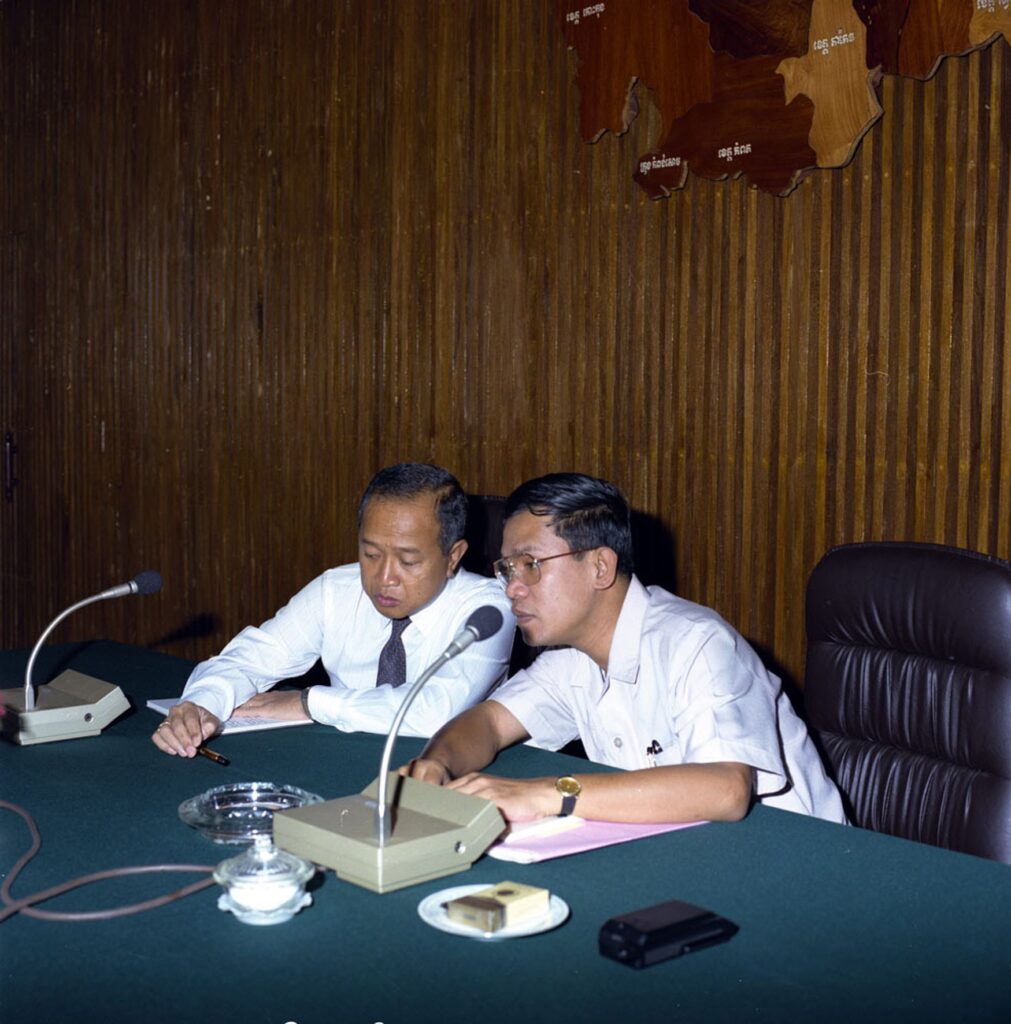
Description | ការពិពណ៌នា
Photograph: Heide Smith. Courtesy of the Australian War Memorial, P03258.295
Cambodia’s prime ministers, His Royal Highness (HRH) Prince Norodom Ranariddh (left), leader of the National United Front for an Independent, Neutral, Peaceful and Cooperative Cambodia (FUNCINPEC) Party and Hun Sen, leader of the Cambodian People’s Party (CPP) conducting business in the Cabinet Room of the Constitutional Assembly building in Phnom Penh on the morning of 10 August 1993. Above them is a map of Cambodia divided into provinces. The May 1993 elections, supervised by the United Nations Transitional Authority in Cambodia (UNTAC), gave FUNCINPEC 45.47 percent of the national vote, entitling them to 58 seats in the Assembly, while the CPP polled 38.23 percent and 51 seats. The two parties subsequently decided to form a power sharing government.
1993
នាយករដ្ឋមន្ត្រីប្រទេសកម្ពុជាទាំងពីរគឺ សម្ដេចក្រុមព្រះនរោត្តម រណឬទ្ធិ (នៅខាងឆ្វេង) ជាព្រះប្រធានគណរណសិរ្សរួបរួមជាតិ ដើម្បីឯករាជ្យ អព្យាក្រឹត សន្តិភាព និងសហប្រតិបត្តិការកម្ពុជា (ហ្វ៊ុនស៊ិនប៉ិច) និងលោកនាយករដ្ឋមន្ត្រី ហ៊ុន សែន ប្រធានគណប្រជាជនកម្ពុជា ( គបក) កំពុងធ្វើកិច្ចប្រជុំមួយនៅក្នុងបន្ទប់គណៈរដ្ឋមន្ត្រីនៃអគាររដ្ឋធម្មនុញ្ញនៅរាជធានីភ្នំពេញ នៅព្រឹកថ្ងៃទី១០ ខែសីហា ឆ្នាំ១៩៩៣។ នៅខាងលើពួកគាត់គឺជាផែនទីរបស់ប្រទេសកម្ពុជាដែលបានបែកចែកជាខេត្តផ្សេងៗ។ ក្នុងការបោះឆ្នោតខែឧសភា ឆ្នាំ១៩៩៣ ដែលបានត្រួតពិនិត្យដោយអ៊ុនតាក់ គណបក្សហ្វ៊ុនស៊ិនប៉ិចទទួលបាន ៤៥.៤៧% ដែលស្មើនិង៥៨កៅអីក្នុងសភា រីឯគណបក្សប្រជាជនកម្ពុជាទទួលបានសន្លឹកឆ្នោត ៣៨.២៣% ស្មើនិង៥១កៅអី។ ក្រោយមកគណបក្សទាំងពីរក៏បានសម្រេចចិត្តចែករំលែកអំណាចគ្រប់គ្រងរដ្ឋាភិបាលជាមួយគ្នា។
១៩៩៣
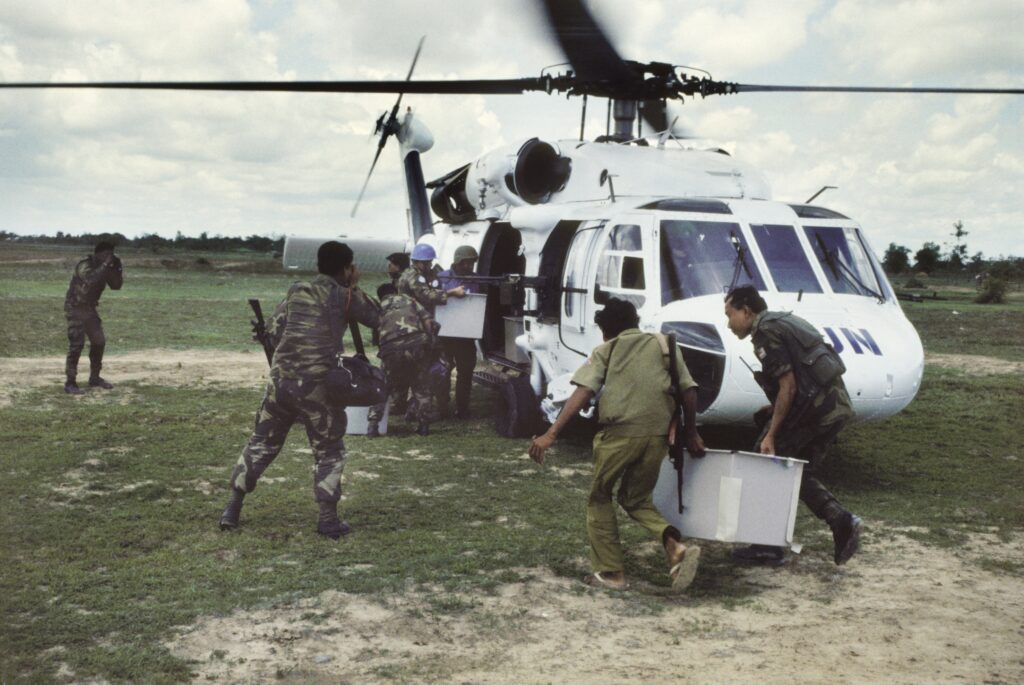
Description | ការពិពណ៌នា
Photograph: George Gittoes. Courtesy of the Australian War Memorial, P01744.029
Soldiers serving with the United Nations Transitional Authority in Cambodia (UNTAC) load ballot boxes full of completed election voting papers into an Army Black Hawk helicopter, which has been painted in the white of the United Nations (UN).
May 1993
ទាហានដែលបម្រើការជាមួយអាជ្ញាធរអន្តរកាលសហប្រជាជាតិនៅកម្ពុជា (អ៊ុនតាក់) កំពុងលើកធុងឆ្នោតដែលពេញទៅដោយសន្លឹកឆ្នោតដែលបោះរួច ដាក់លើឧទ្ធម្ភាគចក្រទ័ព Black Hawk ដែលត្រូវបានលាបព័ណ៌សតំណាងឱ្យអង្គការសហប្រជាជាតិ (UN)។
ខែឧសភា ឆ្នាំ១៩៩៣
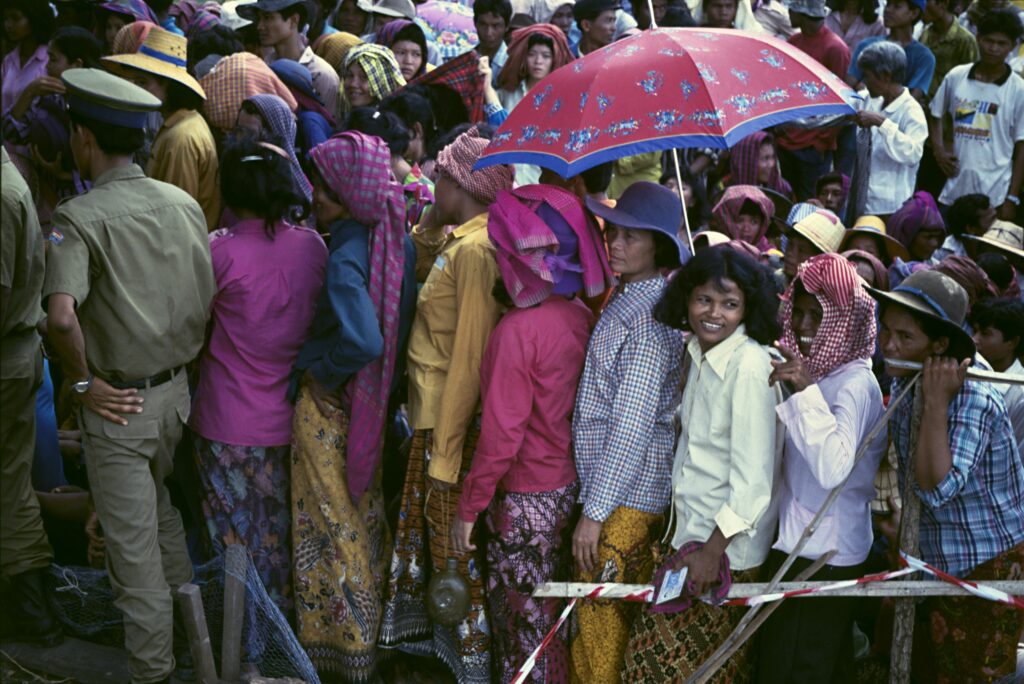
Description | ការពិពណ៌នា
Photograph: George Gittoes. Courtesy of the Australian War Memorial, P01744.056
A large crowd of colourfully dressed Cambodian villagers gathered at a rural polling station to vote in the Cambodian national elections. At left, a Cambodian policeman is helping to control the crowd at the entrance to the polling station.
អ្នកភូមិនៅកម្ពុជាយ៉ាងច្រើនកុះករដែលស្លៀកពាក់ផ្សេងៗគ្នាបានជួបជុំគ្នានៅមណ្ឌលបោះឆ្នោតជនបទមួយដើម្បីត្រៀមបោះឆ្នោតក្នុងព្រឹត្តិការណ៍បោះឆ្នោតជាតិ។ នៅខាងឆ្វេងដៃ ប៉ូលិសកម្ពុជាម្នាក់កំពុងជួយសម្រួលក្រុមមនុស្សនៅខាងមុខច្រកចូលឱ្យចូលទៅកាន់មណ្ឌលបោះឆ្នោត។
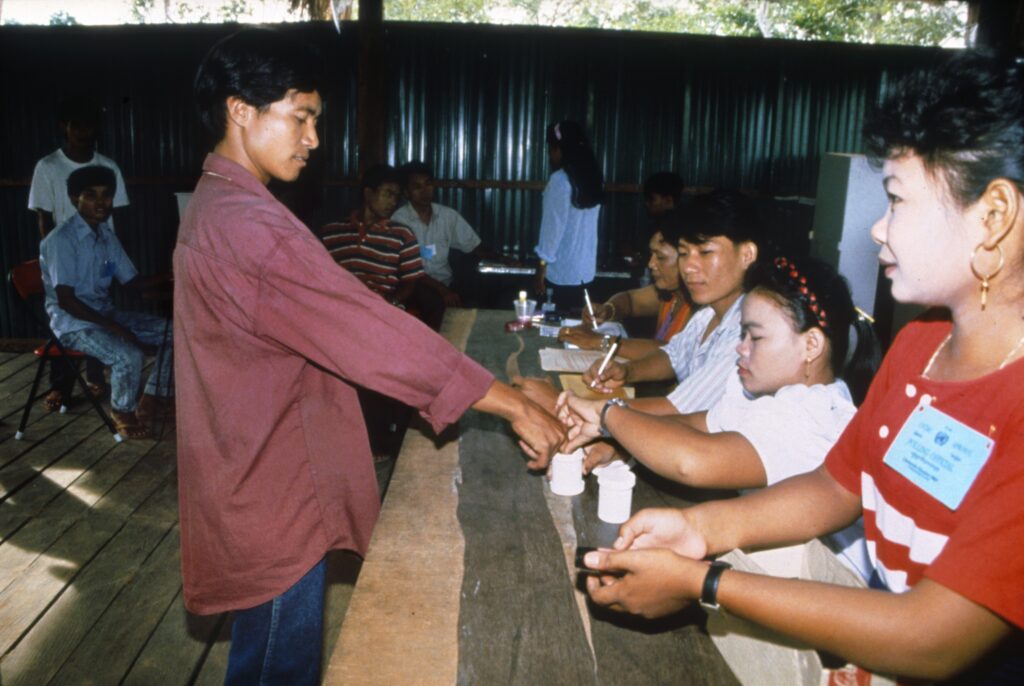
Description | ការពិពណ៌នា
Photograph: George Gittoes. Courtesy of the Australian War Memorial, P01744.078
Electoral officials at a rural polling station rehearse procedures for voting in the forthcoming Cambodian national elections, which were sponsored by the United Nations Transitional Authority in Cambodia (UNTAC). The man standing at left is an official who is playing the part of a voter in the rehearsal. His fingerprint is being taken as part of the process of registering him as a voter.
May 1993
មន្ត្រីរៀបចំការបោះឆ្នោតមួយចំនួន នៅមណ្ឌលបោះឆ្នោតជនបទមួយ បានអនុវត្តសមអំពីនីតិវិធីដើម្បីបោះឆ្នោតជាតិដែលនឹងធ្វើឡើងនាពេលខាងមុខ ដែលរៀបចំដោយអ៊ុនតាក់។ បុរសម្នាក់ដែលឈរនៅខាងឆ្វេងគឺជាមន្ត្រីរៀបចំការបោះឆ្នោតដែលកំពុងហាត់សមក្នុងការបោះឆ្នោតដែលស្នាមដៃរបស់គាត់ត្រូវបានយកនៅក្នុងដំណើរការនៃការចុះឈ្មោះគាត់ធ្វើជាអ្នកបោះឆ្នោត។
ខែឧសភា ឆ្នាំ១៩៩៣
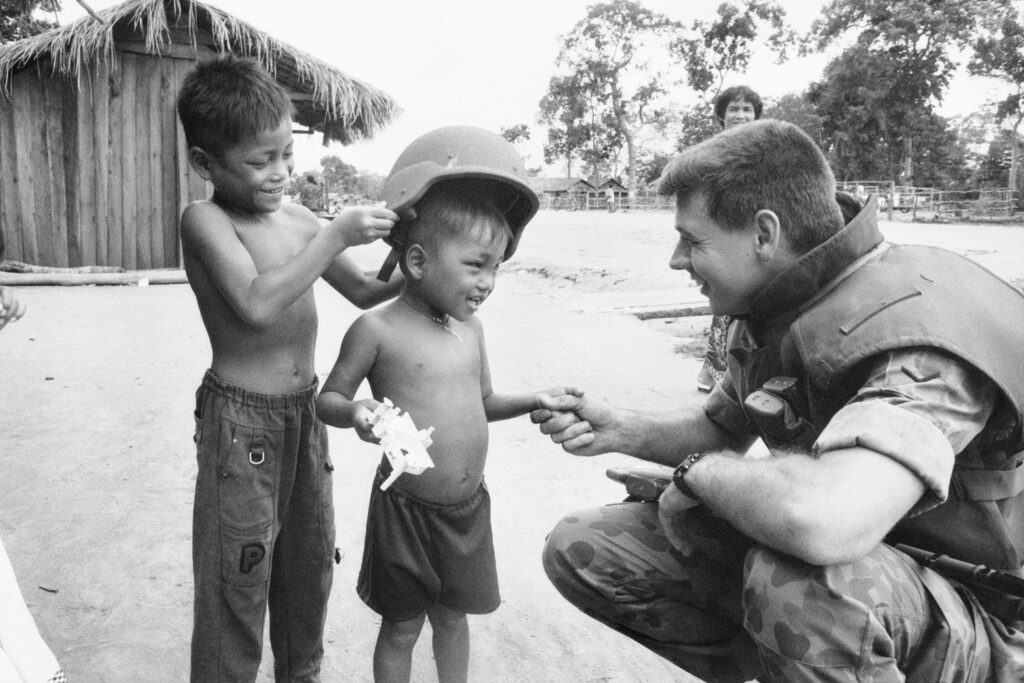
Description | ការពិពណ៌នា
Photograph: George Gittoes. Courtesy of the Australian War Memorial, P01744.168
An Australian soldier serving with the United Nations Transitional Authority in Cambodia(UNTAC) stops to make friends with two Cambodian children, while patrolling a street in a large town. The soldier is wearing a flak jacket over his jungle green uniform.
June 1993
ទាហានអូស្ត្រាលីម្នាក់ដែលបម្រើការឱ្យអាជ្ញាធរអន្តរកាលសហប្រជាជាតិនៅកម្ពុជា (អ៊ុនតាក់) បានឈប់ដើម្បីសំណេះសំណាលជាមួយក្មេងកម្ពុជា២រូប ខណៈដែលកំពុងដើរល្បាតតាមដងផ្លូវក្នុងទីក្រុងធំមួយ។ ទាហានម្នាក់នោះពាក់អាវក្រោះការពារពីលើឯកសណ្ឋានដើរព្រៃព័ណ៌បៃតងរបស់គាត់។
ខែមិថុនា ឆ្នាំ1993
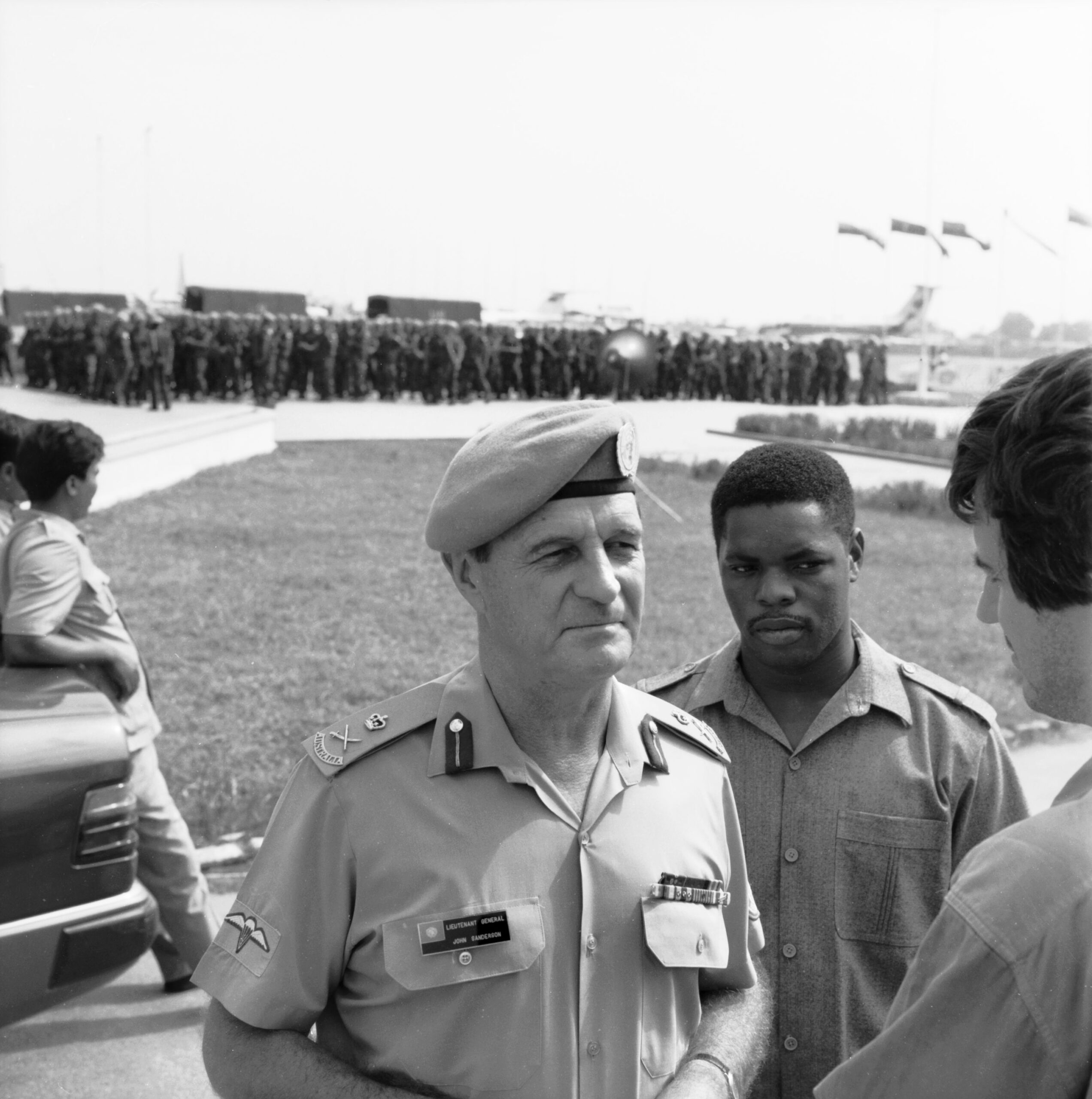
Description | ការពិពណ៌នា
Photograph: Heide Smith. Courtesy of the Australian War Memorial, P03258.001
Lieutenant General (Lt Gen) John M Sanderson, Force Commander of the military component of the United Nations Transitional Authority in Cambodia (UNTAC) is interviewed by a reporter at Phnom Penh Airport.
1993
ឧត្តមសេនីយ៍ឯក John M Sanderson អគ្គមេបញ្ជការទ័ពអាជ្ញាធរអន្តរកាលអង្គការសហប្រជាជាតិនៅកម្ពុជា (អ៊ុនតាក់) កំពុងផ្ដល់បទសម្ភាសន៍ដល់អ្នកសារព័ត៌មានម្នាក់នៅអាកាសយានដ្ឋានភ្នំពេញ។
ឆ្នាំ១៩៩៣
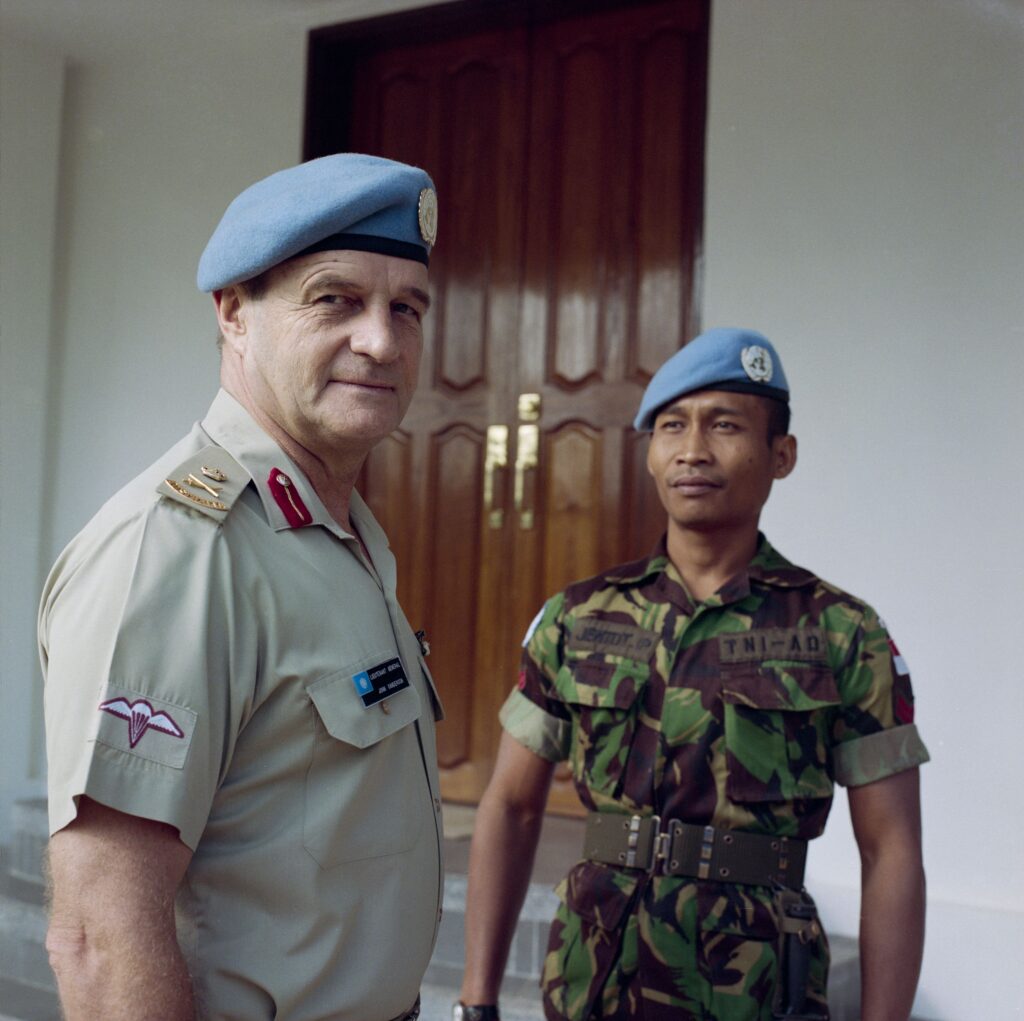
Description | ការពិពណ៌នា
Photograph: Heide Smith. Courtesy of the Australian War Memorial, P03258.004
Lieutenant General (Lt Gen) John M Sanderson (left), Force Commander of the Military Contingent of the United Nations Transitional Authority in Cambodia (UNTAC) stands with a member of the Indonesian Army Contingent, whose left breast bears a patch with the initials ‘TNI-AD’ (Tentara Nasional Indonesia Angkatan Darat), while his right breast bears his name (Jentot?). The Indonesian Contingent was deployed in a security capacity to the Phnom Penh Special Zone (PPSZ) for the duration of the electoral period, from October 1992 onwards.
1993
ឧត្តមសេនីយ៍ឯក John M Sanderson (ខាងឆ្វេង) អគ្គមេបញ្ជាការកងទ័ពជំនួយរបស់អាជ្ញាធរអន្តរកាលសហប្រជាជាតិនៅកម្ពុជា (អ៊ុនតាក់) ឈរជាមួយទ័ពជំនួយឥណ្ឌូនេស៊ីម្នាក់ ដែលទ្រូងខាងឆ្វេងរបស់គាត់ពាក់ពាក្យថា ‘TNI-AD’ ឯទ្រូងខាងស្ដាំពាក់ឈ្មោះរបស់គាត់ (Jentot?)។ ទ័ពឥណ្ឌូនេស៊ីម្នាក់នោះត្រូវបានដាក់ឱ្យមើលការខុសត្រូវសន្តិសុខក្នុងតំបន់ពិសេសភ្នំពេញសម្រាប់រយៈពេលនៃការបោះឆ្នោតចាប់ពីខែតុលា ឆ្នាំ១៩៩២ តទៅ។
១៩៩៣
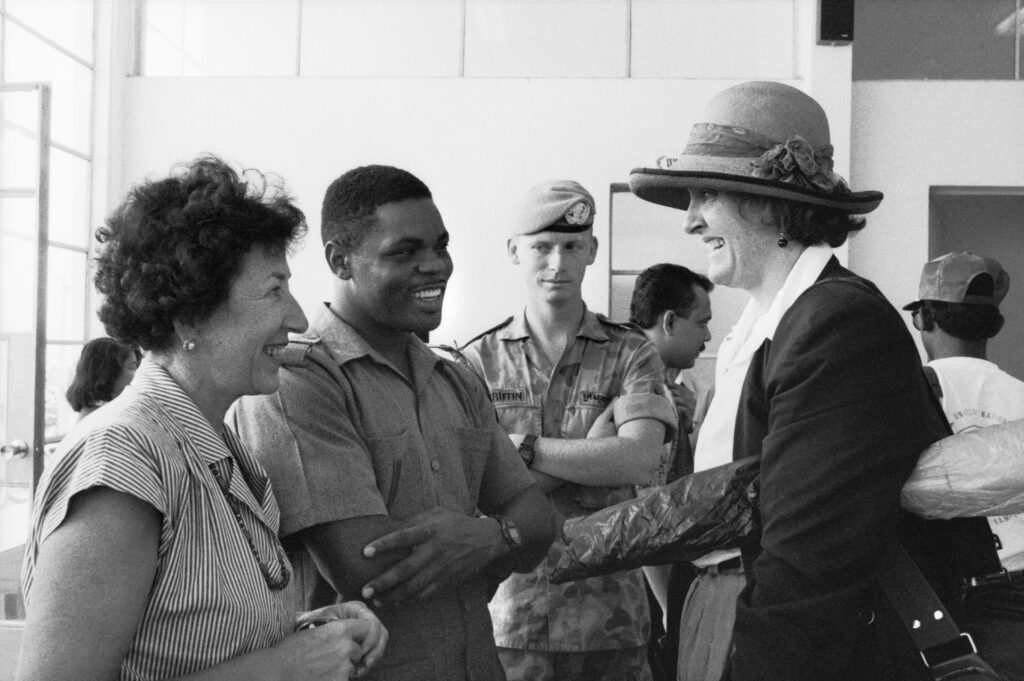
Description | ការពិពណ៌នា
Photograph: Heide Smith. Courtesy of the Australian War Memorial, P03258.006
Lorraine Sanderson (left), wife of Lieutenant General (Lt Gen) John M Sanderson, Force Commander of the Military Contingent of the United Nations Transitional Authority in Cambodia (UNTAC) greets Marje Prior (right) at Phnom Penh Airport in January 1993. Standing between them is Lt Gen Sanderson’s Ghanaian bodyguard and 2306425 Corporal (Cpl) Griffin. Journalist Marje Prior and photographer Heide Smith visited Cambodia in January and August 1993 to document Australian involvement with UNTAC, later publishing a book entitled ‘Shooting at the Moon -Cambodian Peacekeepers tell their stories’.
1993
លោកស្រី Lorraine Sanderson (ខាងឆ្វេង) ភរិយារបស់លោកឧត្តមសេនីយ៍ឯក John M Sanderson អគ្គមេបញ្ជាការកងទ័ពជំនួយរបស់អាជ្ញាធរអន្តរកាលសហប្រជាជាតិនៅកម្ពុជា (អ៊ុនតាក់) ទទួលស្វាគមន៍លោកស្រី Marje Prior (ខាងស្ដាំ) នៅអាកាសយានដ្ឋានភ្នំពេញក្នុងខែមករា ឆ្នាំ១៩៩៣។ ឈរនៅចន្លោះពួកគាត់នោះគឺអង្គរក្សរបស់លោកឧត្តមសេនីយ៍ឯក John M Sanderson សញ្ជាតិហ្គាណា និងលោកពលបាលទោ (Cpl) Griffin។ អ្នកសារព័ត៌មាន លោកស្រី Marje Prior និងជាងថតរូប អ្នកស្រី Heide Smith បានមកកាន់ប្រទេសកម្ពុជាក្នុងខែមករា និងខែសីហា ឆ្នាំ១៩៩៣ ដើម្បីចងក្រងឯកសារអំពីការចូលរួមរបស់ប្រទេសអូស្ត្រាលីជាមួយអ៊ុនតាក់ ហើយក្រោយមកក៏បានបោះពុម្ពសៀវភៅមួយក្បាលចំណងជើងថា ‘Shooting at the Moon -Cambodian Peacekeepers tell their stories’ ។
១៩៩៣
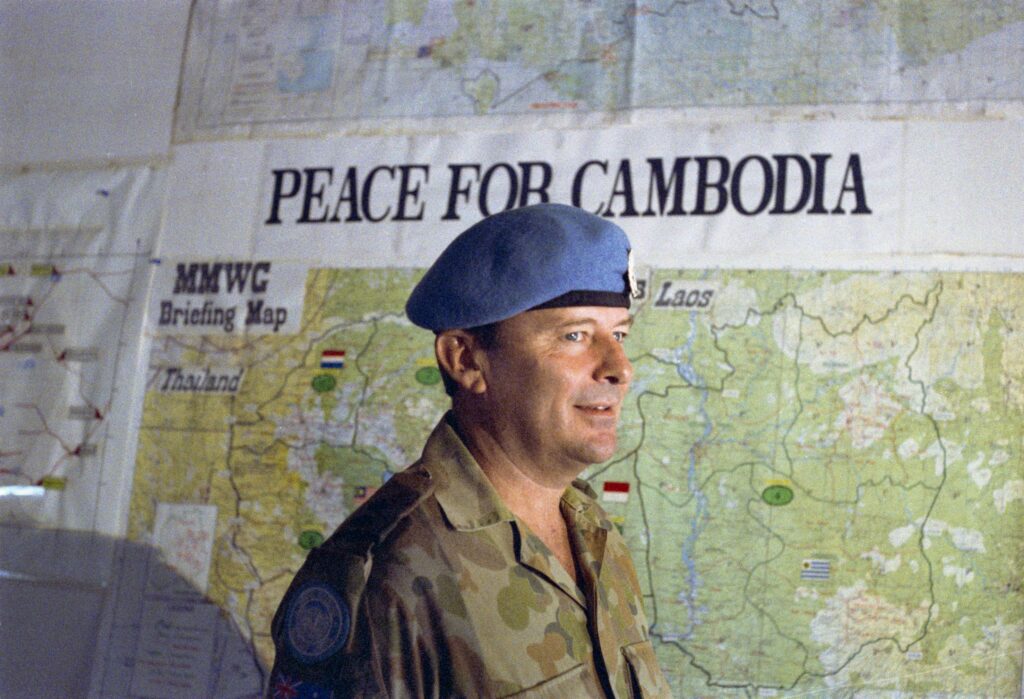
Description | ការពិពណ៌នា
Photograph: Heide Smith. Courtesy of the Australian War Memorial, P03258.008
An informal portrait of 219689 Lieutenant Colonel (Lt Col) Damien Healy standing in front of a Mixed Military Working Group (MMWG) briefing map which displays the legend ‘Peace For Cambodia’ and shows the location of United Nations Transitional Authority in Cambodia (UNTAC)’s military contingents. The MMWG had been formed by the United Nations Advance Mission in Cambodia (UNAMIC) with the intention of providing a high-level forum for all four Cambodian military factions and the UN’s military representatives, and first met on 28 December 1991. It continued under the United Nations Transitional Authority in Cambodia (UNTAC). An experienced military negotiator, Lt Col Healy was MMWG’s Chief Liaison Officer and the only Australian representative. He received a Conspicuous Service Cross for his work in Cambodia.
1993
នេះគឺជារូបភាពរបស់លោកវរសេនីយ៍ឯក Damien Healy ឈរនៅពីមុខផែនទីសង្ខេបរបស់ក្រុមការងារទ័ពចម្រុះ ដែលមានពាក្យស្លោកថា “សន្តិភាពសម្រាប់ប្រទេសកម្ពុជា” ហើយនិងបង្ហាញទីតាំងទ័ពរបស់អាជ្ញាធរអន្តរកាលសហប្រជាជាតិនៅកម្ពុជា (អ៊ុនតាក់)។ ក្រុមការងារទ័ពចម្រុះ (MMWG) ត្រូវបានបង្កើតឡើងដោយបេសកកម្មពិសេសអង្គការសហប្រជាជាតិនៅកម្ពុជា (UNAMIC) ក្នុងគោលបំណងដើម្បីផ្ដល់វេទិកាចរចាកម្រិតខ្ពស់មួយដល់ក្រុមប្រដាប់អាវុធទាំង៤ភាគីនិងតំណាងទ័ពរបស់អង្គការសហប្រជាជាតិ ហើយជួបប្រជុំដំបូងនៅថ្ងៃទី២៨ ខែធ្នូ ឆ្នាំ១៩៩១។ វាក៏នៅតែបន្តដំណើរការនៅក្រោមការគ្រប់គ្រងរបស់អាជ្ញាធរអន្តរកាលសហប្រជាជាតិនៅកម្ពុជា (អ៊ុនតាក់)។ លោកវរសេនីយ៍ឯក Damien Healy គឺជាអ្នកចរចាផ្នែកយោធាដែលមានបទពិសោធខ្ពស់ និងជាមន្ត្រីទំនាក់ទំនងរបស់ក្រុមការងារទ័ពចម្រុះ (MMWG) ហើយក៏ជាអ្នកតំណាងឱ្យប្រទេសអូស្ត្រាលីតែម្នាក់គត់។ គាត់បានទទួលរង្វាន់កិត្តិយស Conspicuous Service Cross សម្រាប់ការងាររបស់គាត់នៅប្រទេសកម្ពុជា។
១៩៩៣
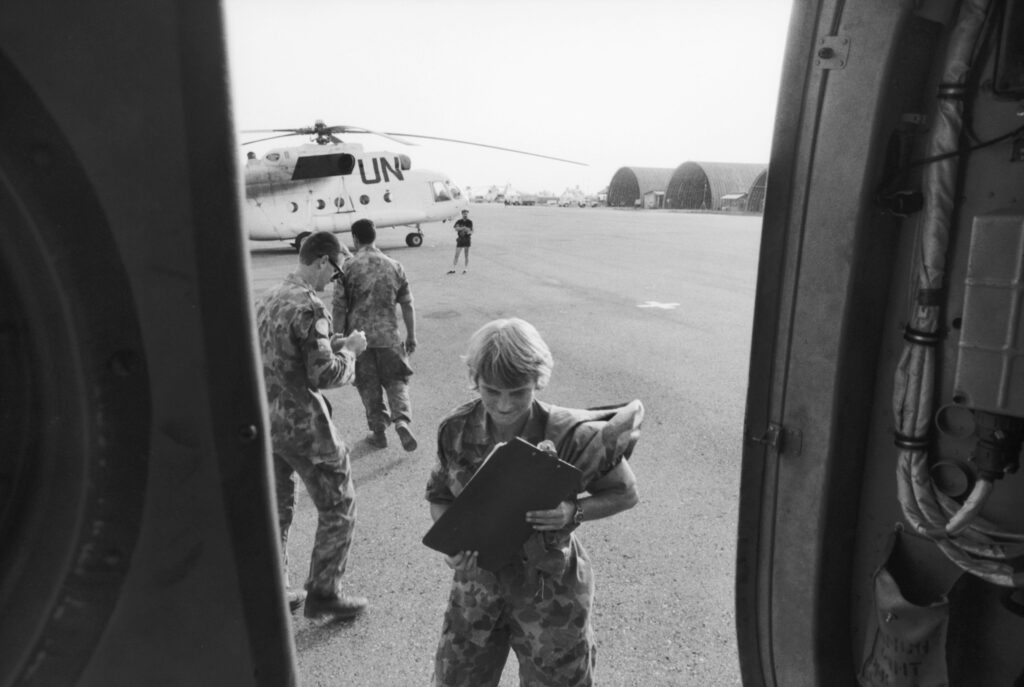
Description | ការពិពណ៌នា
Photograph: Heide Smith. Courtesy of the Australian War Memorial, P03258.012
F237162 Corporal Jenny Brauer, Air Dispatch Service team, Australian Force Communications Unit (FCU) holds a clipboard as she prepares to reboard a UN Mi-8 helicopter at Battambang Airfield in late January 1992. 183584 Bombardier H J Hooker, FCU, and an unidentified Australian walk away immediately behind her, while a civilian, possibly one of the contracted Russian helicopter pilots, stands in the middle distance next to another UN Mi-8. In the
far distance to the left of three large hangars there are a number of UN trucks and a Russian Mi-26 ‘Halo’ transport helicopter, all painted in the traditional white UN finish. United Nations Transitional Authority in Cambodia (UNTAC) helicopters made regular supply and mail runs to UNTAC bases, but found the northwest of Cambodia potentially dangerous as a number of helicopters were hit by ground fire, usually when travelling close to Khmer Rouge controlled areas.
1993
ពលបាលទោ Jenny Brauer សមាជិកាក្រុមសេវាកម្មដឹកជញ្ជូនតាមអាកាស និងអង្គភាពទំនាក់ទំនងទ័ពអូស្ត្រាលី កំពុងកាន់ clipboard ខណៈពេលដែលនាងរៀបចំបើកឧទ្ធម្ភាគចក្រ UN Mi-8 នៅអាកាសយាន្តដ្ឋានបាត់ដំបងនៅចុងខែមករា ឆ្នាំ១៩៩២។ អ្នកបើកយន្តហោះទម្លាក់គ្រាប់បែក លោក H J Hooker និងជនជាតិអូស្ត្រាលីដែលមិនស្គាល់អត្តសញ្ញាណម្នាក់បានដើរចេញពីខាងក្រោយនាង ខណៈដែលជនស៊ីវិលម្នាក់ ប្រហែលជាអាកាសយានិកម្នាក់នៃក្រុមអាកាសយានិកឧទ្ធម្ភាគចក្ររុស្សី ឈរនៅចំកណ្ដាល ឆ្ងាយបន្តិច ជិតនឹងឧទ្ធម្ភាគចក្រ UN Mi-8 មួយទៀត។ នៅខាងក្រោយឆ្ងាយសន្លឹម ឆ្វេងដៃមានឃ្លាំងធំៗ៣ ដែលមានផ្ទុកឡានដឹកទំនិញរបស់អង្គការសហប្រជាជាតិ និងឧទ្ធម្ភាគចក្រដឹកជញ្ជូន Mi-26 ‘Halo’ របស់រុស្សីមួយចំនួន ដែលត្រូវបានលាបពណ៍សតាមបែបអង្គការសហប្រជាជាតិ។ ឧទ្ធម្ភាគចក្រអាជ្ញាធរអន្តរកាលសហប្រជាជាតិនៅកម្ពុជា (អ៊ុនតាក់) តែងតែដឹកស្បៀង និងផ្ញើព័ត៌មានទៅកាន់ទីតាំងសំខាន់ៗរបស់អ៊ុនតាក់ ប៉ុន្តែនៅទិសអាគ្នេយ៍នៃប្រទេសកម្ពុជាគឺជាតំបន់ដែលមានសក្តានុពលគ្រោះថ្នាក់ខ្ពស់ ព្រោះឧទ្ធម្ភាគចក្រមួយចំនួនត្រូវបានវាយប្រហារដោយការបាញ់ពីខាងក្រោម ជាទូទៅនៅពេលធ្វើដំណើរក្បែរតំបន់ដែលខ្មែរក្រហមគ្រប់គ្រង។
១៩៩៣
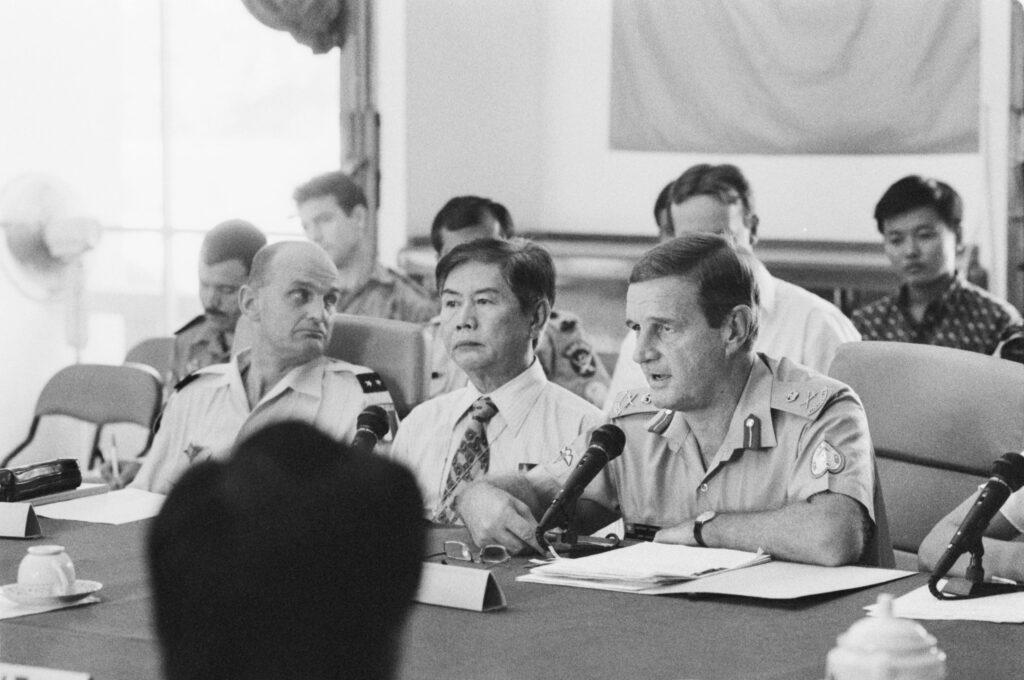
Description | ការពិពណ៌នា
Photograph: Heide Smith. Courtesy of the Australian War Memorial, P03258.018
Lieutenant General (Lt Gen) John M Sanderson (right), Force Commander of the Military Contingent of the United Nations Transitional Authority in Cambodia (UNTAC) speaks at a meeting of the Mixed Military Working Group (MMWG), a high-level forum for all four Cambodian military factions and the UN’s military contingent representatives. An unidentified French UNTAC military contingent representative and a civilian sit next to Lt Gen Sanderson, while a large grouping of UNTAC military representatives sit behind them. First meeting on 28 December 1991, usually at the old colonial French Protector’s Residence in Phnom Penh, the MMWG had been formed by the United Nations Advance Mission in Cambodia (UNAMIC) and continued under UNTAC.
1993
ឧត្តមសេនីយ៍ឯក John M Sanderson អគ្គមេបញ្ជាការកងកម្លាំងប្រដាប់អាវុធរបស់អ៊ុនតាក់ (នៅខាងស្ដាំដៃ) កំពុងមានប្រសាសន៍នៅក្នុងកិច្ចប្រជុំមួយនៃកងយោធាចម្រុះដែលជាវេទិការដ៏ធំមួយសម្រាប់ក្រុមប្រដាប់អាវុធខ្មែរទាំង៤ និងកងទ័ពជំនួយតំណាងឱ្យអង្គការសហប្រជាជាតិ។ អ្នកតំណាងកងទ័ពជំនួយរបស់បារាំងម្នាក់ដែលមិនស្គាល់ឈ្មោះ និងបុរសស៊ីវិលអង្គុយជាប់លោក ឧត្តមសេនីយ៍ឯក John M Sanderson ព្រមទាំងក្រុមតំណាងឱ្យកងទ័ពអ៊ុនតាក់ជាច្រើនអង្គុយពីក្រោយពួកគេ។ កិច្ចប្រជុំលើកដំបូង គឺនៅថ្ងៃទី២៨ ខែធ្នូ ឆ្នាំ១៩៩១ ដែលបានប្រារព្ធឡើងនៅភូមិគ្រិះអាណានិគម បារាំងចាស់មួយនៅក្នុងទីក្រុងភ្នំពេញ។ ក្រុមកងយោធាចម្រុះបានបង្កើតឡើងដោយ ក្រុមបេសកម្មពិសេសអង្គការសហប្រជាជាតិនៅកម្ពុជា និងបន្តរហូតមកដល់អ៊ុនតាក់។
១៩៩៣
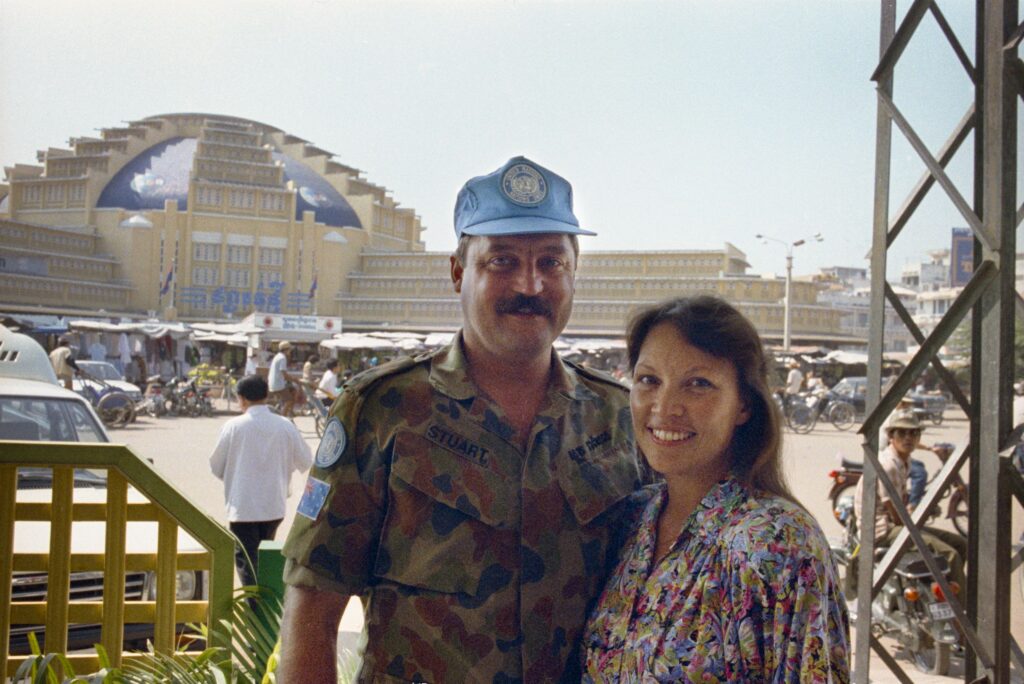
Description | ការពិពណ៌នា
Photograph: Heide Smith. Courtesy of the Australian War Memorial, P03258.031
An informal portrait of 1203543 Lieutenant Colonel (Lt Col) Russell Stuart and his wife Debbie Stuart standing in front of the Central Market in Phnom Penh. The couple were married in Cambodia and, at the insistence of HRH Prince Norodom Sihanouk (who composed and dedicated a song to Debbie Stuart), the reception was held in the Royal Palace in Phnom Penh, the first time that such an honour had been accorded to a foreigner. Lt Col Stuart’s name is reproduced in the Khmer language above his left pocket. Lt Col Stuart was awarded the Conspicuous Service Cross for his contribution to the planning for Australian participation in UN operations in Cambodia.
1993
នេះគឺជារូបភាពរបស់លោកវរសេនីយ៍ឯក Russell Stuart ជាមួយនឹងភរិយារបស់គាត់គឺលោកស្រី Debbie Stuart ឈរនៅពីមុខផ្សារថ្មីនៅទីក្រុងភ្នំពេញ។ ស្វាមីភរិយាមួយគូនេះបានរៀបអាពាហ៍ពិពាហ៍នៅក្នុងប្រទេសកម្ពុជា ដែលជាការស្នើសុំរបស់សម្តេចនរោត្តមសីហនុ (ទ្រង់ក៏បាននិពន្ធចម្រៀងមួយបទជូនលោកស្រី Debbie Stuart ផងដែរ) ហើយពិធីមង្គលការប្រារព្វឡើងនៅព្រះបរមរាជវាំងភ្នំពេញ។ វាគឺជាពេលដំបូងដែលមហាកិត្តិយសត្រូវរៀបចំឡើងជូនដល់ជនបរទេស។ ឈ្មោះរបស់លោកវរសេនីយ៍ឯក Stuart ក៏បានបកប្រែជាភាសាខ្មែរនៅលើហោប៉ៅអាវខាងឆ្វេងរបសគាត់ទៀតផង។ លោកវរសេនីយ៍ឯក Stuart ក៏ទទួលបានរង្វាន់ Conspicuous Service Cross ផងដែរ សម្រាប់ការចូលរួមចំណែកក្នុងការរៀបចំផែនការឱ្យប្រទេសអូស្ត្រាលីចូលរួមក្នុងកិច្ចសហប្រតិបត្តិការអង្គការសហប្រជាជាតិនៅប្រទេសកម្ពុជា។
១៩៩៣
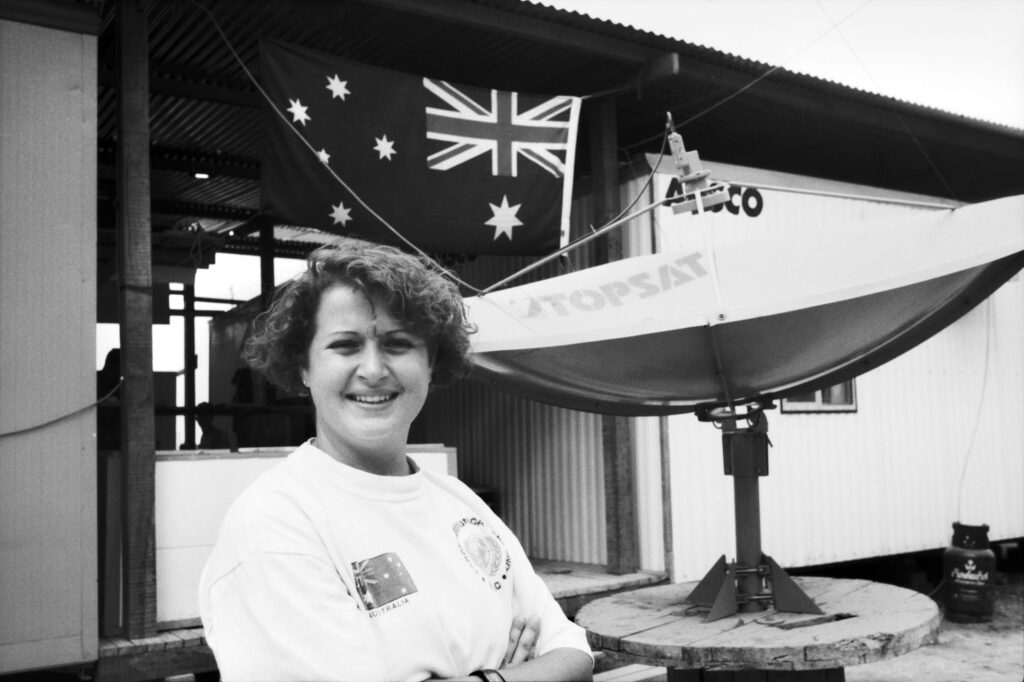
Description | ការពិពណ៌នា
Photograph: Heide Smith. Courtesy of the Australian War Memorial, P03258.035
An informal portrait of W133384 Leading Aircraftwoman (LACW) Kylie Kiddle, one of twenty RAAF personnel serving with the Australian Force Communications Unit (FCU) contingent of the United Nations Transitional Authority in Cambodia (UNTAC), standing in front of a communication dish used at the Siem Reap Unit. Siem Reap, the regional capital of Siem Reap province, was well within the Khmer Rouge sphere of influence and on 3 May 1993 the Khmer Rouge temporarily captured the airport, looted UNTAC buildings and local dwellings, and shelled the town in an attempt to prevent Cambodians registering for voting.
1993
នេះគឺជារូបភាពរបស់នារីបើកយន្តហោះឈានមុខ Kylie Kiddle ជាស្ត្រីម្នាក់ក្នុងចំណោមស្ត្រី២០នាក់ផ្សេងទៀតដែលបម្រើការឱ្យអង្គភាពទំនាក់ទំនងកងកម្លាំងអូស្ត្រាលីនៅអាជ្ញាធរអន្តរកាលអង្គការសហប្រជាជាតិនៅកម្ពុជា(អ៊ុនតាក់) ឈរនៅពីមុខអង់តែនទំនាក់ទំនងដែលប្រើប្រាស់នៅអង្គភាពខេត្តសៀមរាប។ តំបន់ទីរួមខេត្តសៀមរាប នៅក្នុងតំបន់ដែលខ្មែរក្រហមនៅតែមានឥទ្ធិពលខ្លាំង ហើយនៅថ្ងៃទី៣ ឧសភា ១៩៩៣ ខ្មែរក្រហមបានកាន់កាប់អាកាសយានដ្ឋានបណ្ដោះអាសន្ន លួចអគារអ៊ុនតាក់ និងលំនៅឋានតាមតំបន់ ហើយព្យាយាមការពារក្រុងក្នុងគោលបំណងហាមឃាត់ប្រជាជនមិនឱ្យចុះឈ្មោះបោះឆ្នោត។
១៩៩៣
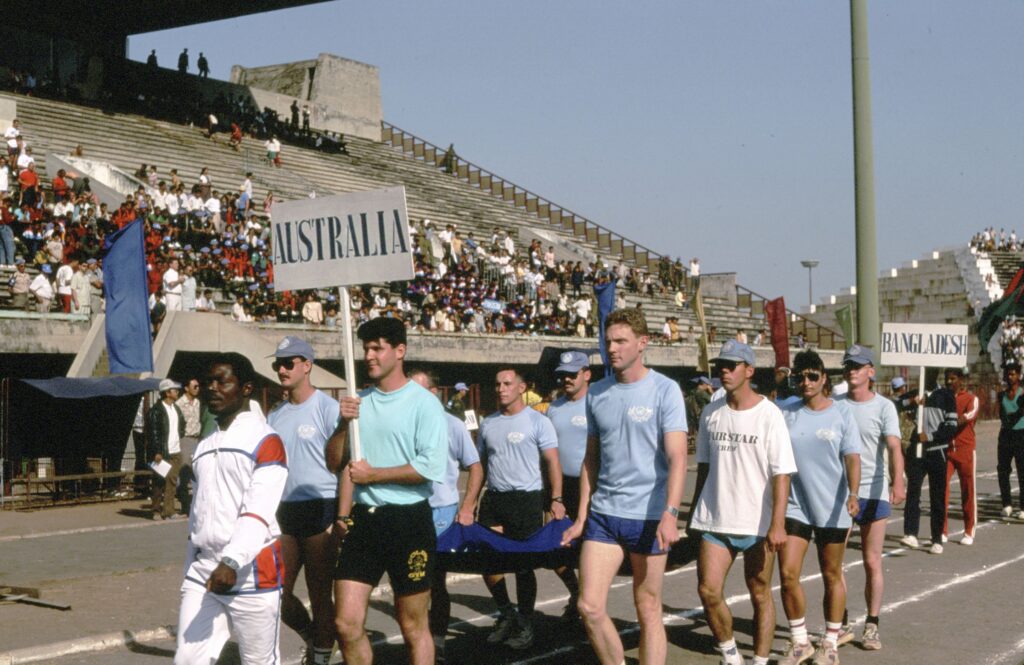
Description | ការពិពណ៌នា
Photograph: Heide Smith. Courtesy of the Australian War Memorial, P03258.071
A group of representatives, including one woman, from the Australian Force Communications Unit (FCU) march at the head of a parade of athletes competing at the first ever UN Olympic games, an event held in Phnom Penh’s 1963 Olympic Stadium on 17 January 1993. They are followed by the representatives from the Bangladeshi contingent which contributed 942 personnel to the United Nations Transitional Authority in Cambodia (UNTAC) operation. Organised by the Australian contingent, the games drew 600 participants from 18 countries.
1993
ថ្ងៃទី១៧ ខែមករា ឆ្នាំ១៩៩៣ ក្រុមកីឡាតំណាងឱ្យអង្គភាពទំនាក់ទំនងអូស្ត្រាលីដែលមានស្ត្រីម្នាក់ផងដែរនោះ បានរៀបក្បួនដង្ហែក្នុងការប្រកួតកីឡាអូឡាំដំបូងបង្អស់ របស់អង្គការសហប្រជាជាតិ ដែលបានរៀបចំនៅពហុកីឡាដ្ឋានភ្នំពេញដែលកសាងឆ្នាំ១៩៦៣។ ពួកគេត្រូវបានដើរពីក្រោយដោយក្រុមតំណាងមកពីបង់ក្លាដេសដែលមានកងទ័ពជំនួយចូលរួមជាមួយអ៊ុនតាក់ចំនួន៩៤២នាក់។ ការប្រកួតដែលរៀបចំដោយប្រទេសអូស្ត្រាលីមួយនេះ បានទាក់ទាញអ្នកចូលរួមចំនួន៦០០នាក់មកពី១៨ប្រទេស។
១៩៩៣
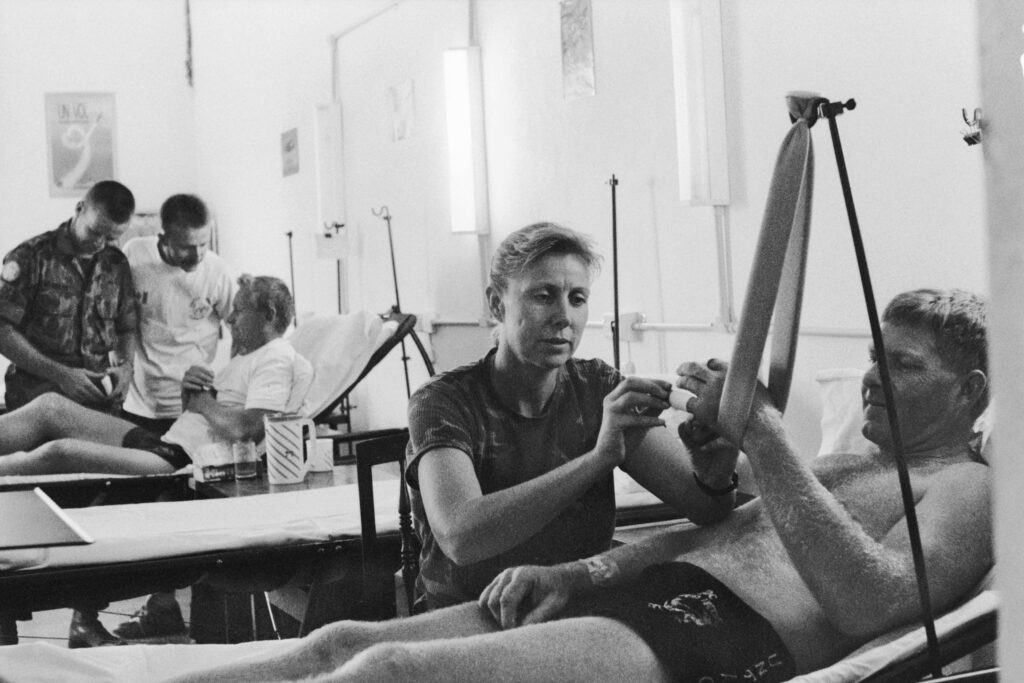
Description | ការពិពណ៌នា
Photograph: Heide Smith. Courtesy of the Australian War Memorial, P03258.074
F230401 Sergeant (Sgt) Norma Hinchcliffe, a medic serving with the Australian Force Communications Unit (FCU) treats a patient at a hospital in Phnom Penh. Sgt Hinchcliffe was a front seat passenger in a Bell 206 JetRanger helicopter on a routine welfare trip from her base at Sisophon to the small signals outpost of Ban Non Sun in Banteay Meanchey province on the Thai border, an area of high Khmer Rouge activity. A suspected Khmer Rouge sniper fired on the helicopter (‘the bullet went straight between our heads’ commented Sgt Hinchcliffe) damaging the controls, radio and hydraulics, and forcing the craft to land on an isolated dirt road to allow the pilot to check for obvious damage. The pilot managed to restart the helicopter and they returned to Sisophon at treetop level ‘with a terrible grinding noise’. This was one of many incidents encountered by United Nations Transitional Authority in Cambodia (UNTAC) troops who operated close to Khmer Rouge controlled territory.
1993
F230401 ពលបាលត្រី (Sgt) Norma Hinchcliffe គឺជាឱសថការិនីកំពុងធ្វើការជាមួយអង្គភាពទំនាក់ទំនងអូស្ត្រាលី ព្យាបាលអ្នកជម្ងឺម្នាក់នៅមន្ទីពេទ្យក្នុងទីក្រុងភ្នំពេញ។ ពលបាលត្រី (Sgt) Norma Hinchcliffe បានអង្គុយកៅអីមុខក្នុងឧទ្ធម្ភាគចក្រ Bell 206 JetRanger នៅក្នុងដំណើរទស្សនកិច្ចសុខមាលភាព ដែលចេញដំណើរពីមូលដ្ឋានក្រុងសិរីសោភ័ណ្ឌ ទៅមូលដ្ឋានតូចនៅភូមិបានណុនសុនក្នុងខេត្តបន្ទាយមានជ័យ ជាប់ព្រំដែនថៃដែលជាតំបន់ពោពេញដោយខ្មែរក្រហម។ ខ្មាន់កាំភ្លើងស៊ីបរបស់ខ្មែរក្រហមបានបាញ់ស៊ីបចំឧទ្ធម្ភាគចក្រដែលគ្រាប់កាំភ្លើងបានហោះបុកមួករបស់ ពលបាលត្រី Sgt Hinchcliffe នឹងខូចខាតគ្រឿងបញ្ជា វិទ្យុ និងធុងទឹកដែលបង្ខំឱ្យឧទ្ធម្ភាគចក្រចុះចតនៅលើផ្លូវលំដាច់ស្រយាលមួយ ដើម្បីត្រួតពិនិត្យការខូចខាត។ អ្នកបើកយន្តហោះក៏រៀបចំឧទ្ធម្ភាគចក្រឡើងវិញហើយក៏ហោះត្រឡប់ទៅក្រុងសិរីសោភ័ណ្ឌត្រឹមកម្ពស់ចុងឈើ និងលឺសម្លេងកកិតយ៉ាងខ្លាំងផងដែរ។ នេះគឺជាឧបទ្ទវហេតុមួយក្នុងចំណោមឧបទ្ទវហេតុជាច្រើនដែលកងទ័ពអ៊ុនតាក់បានជួបប្រទះដែលធ្វើការនៅជិតតំបន់ដែលខ្មែរក្រហមកាន់កាប់។
១៩៩៣
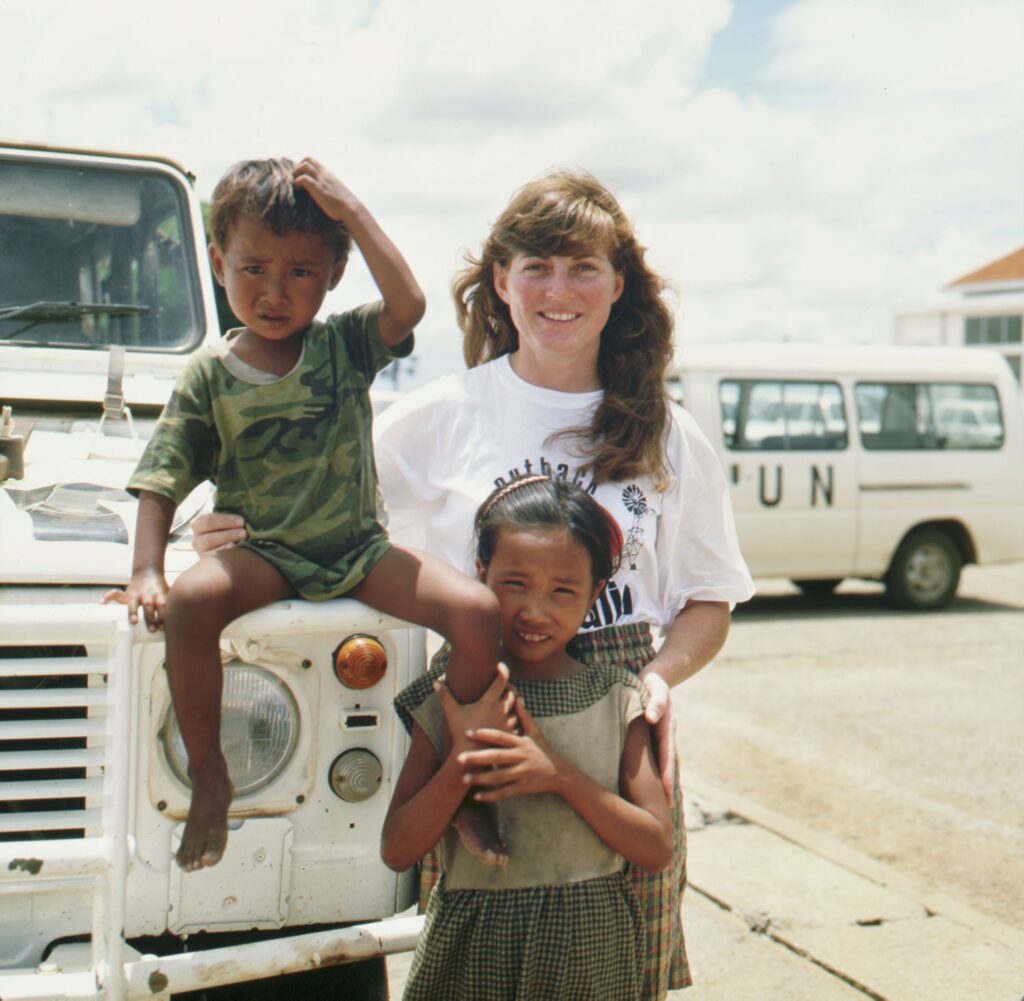
Description | ការពិពណ៌នា
Photograph: Heide Smith. Courtesy of the Australian War Memorial, P03258.085
Sergeant (Sgt) Jodie Clark, Australian Force Communications Unit (FCU) with two homeless street children from the town of Battambang, who sitting on the bonnet of a white UN vehicle used by the United Nations Transitional Authority in Cambodia (UNTAC). A UN transit van is parked in the background. In the spirit of UNTAC’s humanitarian brief, Australian soldiers set up a school for the children of Battambang with money raised through their own fund-raising projects. Sgt Clark would regularly check on these children’s progress and occasionally treat them to a ride in a UN helicopter (see 03258.087 – P03258.089). When the United Nations Transitional Authority in Cambodia (UNTAC) arrived in late 1992, there were at least 200,000 orphans, a rate of infant mortality averaging nine deaths for every 100 pregnancies, a disabled rate of one out of every 238 children (mainly amputees due to landmines), and an average life expectancy of less than 50 years. Many children who experienced the trauma of Cambodia’s history displayed symptoms of extreme dysfunction.
1993
ពលបាលត្រី (Sgt) Jodie Clark អង្គភាពទំនាក់ទំនងកងកម្លាំងអូស្ត្រាលីជាមួយនឹងក្មេងកំព្រា២នាក់មកពីខេត្តបាត់ដំបង ដែលអង្គុយលើឡាន UN ព័ណ៌ស ដែលត្រូវបានប្រើប្រាស់ដោយអ៊ុនតាក់។ ឡានUNមួយចតនៅខាងក្រោយ។ ក្នុងស្មារតីមនុស្សជាតិអ៊ុនតាក់ ទាហានអូស្ត្រាលីបានបង្កើតឱ្យមានសាលារៀនសម្រាប់ក្មេងៗខេត្តបាត់ដំបង ជាមួយនិងថវិកាដែលរៃអង្គាសតាមរយៈគម្រោងមូលនិធិផ្ទាល់របស់ពួកគេ។ ពលបាលត្រី (Sgt) Jodie Clark តែងតែចុះត្រួតពិនិត្យលើការអភិវឌ្ឍរបស់ក្មេងៗទាំងនោះជាប្រចាំ ហើយជួនកាលនាំពួកគេជិះឧទ្ធម្ភាគចក្រ UN ទៀតផង។ នៅពេលអ៊ុនតាក់មកដល់ប្រទេសកម្ពុជានៅចុងឆ្នាំ១៩៩២ ក្មេងកំព្រាមានយ៉ាងតិច ២០០ ០០០នាក់ ហើយអត្រាមរណភាពទារកគឺ ៩ក្នុងចំណោម១០០នាក់ អត្រាជនពិការ ១នាក់ក្នុងចំណោមក្មេង២៣៨នាក់ (ភាគច្រើនពិការដោយគ្រាប់មីន)។ ក្មេងៗជាច្រើនដែលមានបញ្ហាផ្លូវចិត្តដោយសារប្រវត្តិសាស្ត្រថ្មីរបស់កម្ពុជាបានបង្ហាញរោគសញ្ញារាងកាយមិនសូវដំណើរការ។
១៩៩៣
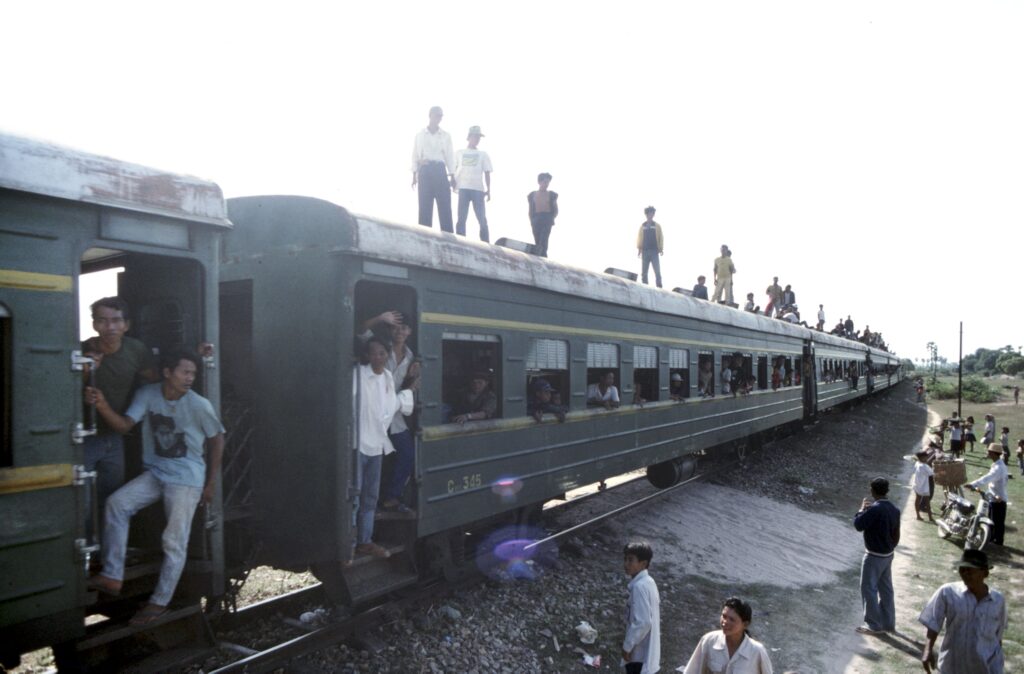
Description | ការពិពណ៌នា
Photograph: Heide Smith. Courtesy of the Australian War Memorial, P03258.102
As the ‘Sisophon Express’, a train full of returning refugee families, draws to a halt on the outskirts of Phnom Penh at the end of a 13 hour journey, passengers wave and lean out of windows whilst others prepare to climb down from their positions on the roof of the train. The 331 families on the train were met by family members and Red Cross, United Nations High Commissioner for Refugees (UNHCR) and CARE International staff who organised transport to the UN reception centre at Phnom Penh. The Repatriation Component of the United Nations Transitional Authority in Cambodia (UNTAC) was responsible for the repatriation and resettling of 370,000 Cambodian refugees located in Thai border camps from April 1992 until March 1993, with only one fatality recorded.
1993
ស៊ីសុផុនអ៊ិចប្រេស គឺជារថភ្លើងដែលផ្ទុកទៅដោយគ្រួសារជនភៀសខ្លួន បាននាំអ្នកទាំងនោះទៅកាន់ជាយទីក្រុងភ្នំពេញដែលប្រើរយៈពេល១៣ម៉ោង អ្នកដំណើរគ្រប់គ្នាបានលើកដៃរា និងអើតតាមបង្អួច ឯអ្នកខ្លះទៀតត្រៀមខ្លួនចុះពីលើដំបូលរថភ្លើង។ គ្រួសារទាំង៣៣១ដែលនៅលើរថភ្លើងបានជួបជុំសមាជិកឡើងវិញ ព្រមទាំងបុគ្គលិកអង្គការកាកបាទក្រហម ភ្នាក់ងារជនភៀសខ្លួនអង្គការសហប្រជាជាតិ និង អង្គការអន្តរជាតិ Care ដែលបានរៀបចំការធ្វើដំណើរទៅកាន់មណ្ឌលបដិសណ្ឋារកិច្ចអង្គការសហប្រជាជាតិនៅទីក្រុងភ្នំពេញ។ ក្រុមរៀបចំមាតុភូមិនិវត្តន៍របស់អ៊ុនតាក់មានតួនាទីក្នុងការនាំប្រជាជនត្រឡប់មកវិញនិងរៀបចំទីជម្រកសម្រាប់ជនភៀសខ្លួនកម្ពុជាចំនួន៣៧០ ០០០នាក់ ដែលភៀសខ្លួនទៅនៅជម្រំជាយដែនថៃ ចាប់ពីខែមេសា១៩៩២ ដល់ខែមីនា ១៩៩៣ ដែលមានតែម្នាក់ប៉ុណ្ណោះស្លាប់ក្នុងការរៀបចំនេះ។
១៩៩៣
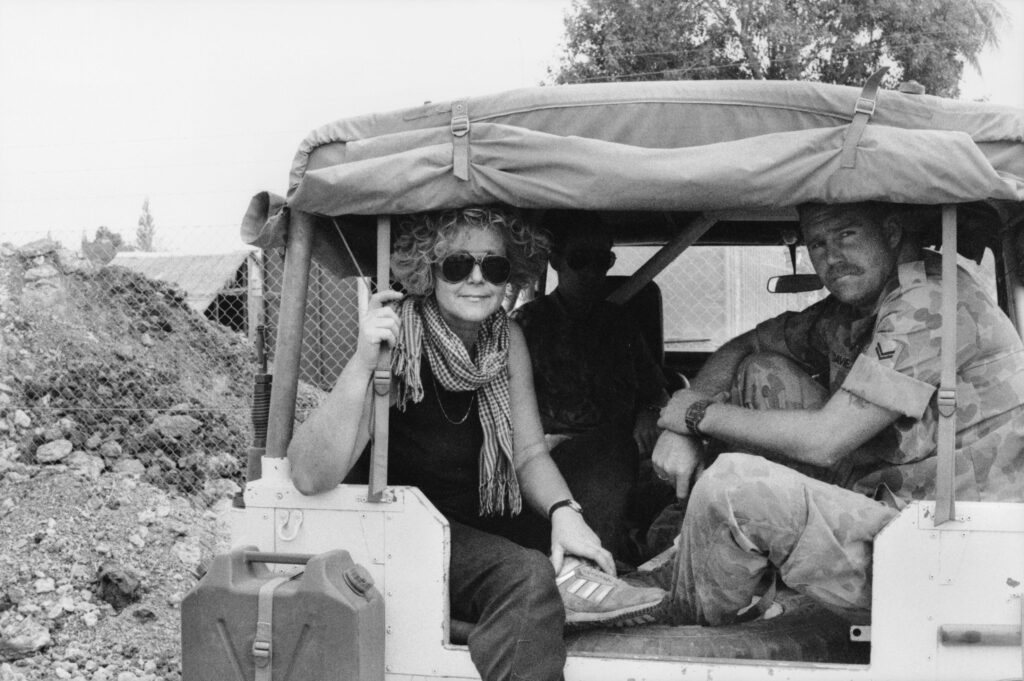
Description | ការពិពណ៌នា
Photograph: Unknown. Courtesy of the Australian War Memorial, P03258.175
Australian photographer Heide Smith poses for a quick shot as she sits in the back of an Australian Force Communications Unit (FCU) vehicle which is approaching the Australian Federal Police base at Thmar Puok in Banteay Meanchey Province, also known as the ‘Liberated Zone’. The Liberated Zone, previously under total Khmer Rouge control, came under the shared command of the four Cambodian political factions (including the Khmer Rouge) as a result of the Paris Peace Accord of 23 October 1991. An unidentified Australian corporal sits opposite Smith.
1993
Heide Smith គឺជាអ្នកថតរូបជនជាតិអូស្ត្រាលី បានអង្គុយថតរូបនៅកៅអីក្រោយក្នុងឡានរបស់កងកម្លាំងអង្គភាពទំនាក់ទំនងអូស្ត្រាលី ដែលឡានកំពុងចេញដំណើរទៅកាន់បន្ទាយសហព័ន្ធប៉ូលិសអូស្ត្រាលី មានមូលដ្ឋាននៅស្រុកថ្មពួក ខេត្តបន្ទាយមានជ័យ ដែលត្រូវបានស្គាល់ថាជាតំបន់រំដោះផងដែរ។ តំបន់រំដោះនេះពីមុនគឺនៅក្រោមការគ្រប់គ្រងរបស់ខ្មែរក្រហម ជាលទ្ធផលបន្ទាប់ពីចុះកិច្ចព្រមព្រៀងសន្តិភាពទីក្រុងប៉ារីសថ្ងៃ២៣ តុលា ឆ្នាំ១៩៩១ ក៏បាននៅក្រោមការគ្រប់គ្រងរបស់ក្រុមប្រដាប់អាវុធខ្មែរទាំង៤វិញ រួមបញ្ចូលទាំងខ្មែរក្រហមផងដែរ។ នាយទាហានអូស្ត្រាលីម្នាក់ដែលអង្គុយទល់មុខ Smith មិនត្រូវបានស្គាល់អត្តសញ្ញាណឡើយ។
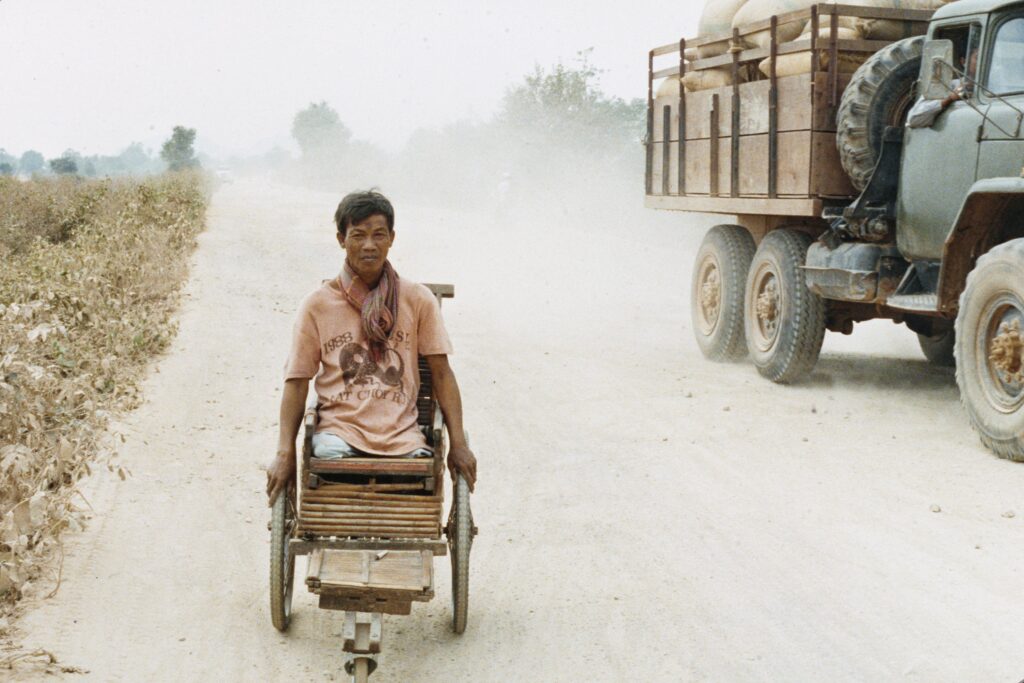
Description | ការពិពណ៌នា
Photograph: Heide Smith. Courtesy of the Australian War Memorial, P03258.189
On the road from the United Nations Transitional Authority in Cambodia (UNTAC) base at Battambang to the unofficial Khmer Rouge capital of Pailin, an amputee in a crude wooden framed wheelchair makes his way through the dust thrown up by passing trucks and cars. Land mines, which have destroyed this man’s legs and probably his livelihood, have been used at a rate and with such indiscretion that, during the 1990s, over 300 Cambodians were killed or maimed by mines every month, despite attempts by the Cambodian Mine Action Centre (CMAC) to maintain a clearance programme.
1993
បុរសពិការម្នាក់បានធ្វើដំណើរដោយរទេះរុញឈើមួយឆ្លងកាត់ផ្លូវលំ ដែលពោរពេញដោយដីហុយបង្កដោយឡានធំតូចជាច្រើន នៅតាមដងផ្លូវពីមូលដ្ឋានអ៊ុនតាក់ក្នុងខេត្តបាត់ដំបងទៅខេត្តប៉ៃលិន ដែលនៅក្រោមការគ្រប់គ្រងមិនផ្លូវការបស់ខ្មែរក្រហម។ គ្រាប់មីនបានបំផ្លាញជើងរបស់គាត់ និងអាចបំផ្លាញការរស់នៅរបស់គាត់ផងដែរ។ គ្រាប់មីនត្រូវបានប្រើប្រាស់យ៉ាងច្រើន ក្នុងកំឡុងទស្សវត្សរ៍១៩៩០ ដែលមានប្រជាជនប្រមាណ៣០០នាក់បានស្លាប់ និងពិការជារៀងរាល់ខែ ប៉ុន្តែក៏មានក្រុមអង្គភាពស៊ីម៉ាក់ខិតខំប្រឹងប្រែងធ្វើកម្មវិធីសម្អាតផងដែរ។
១៩៩៣
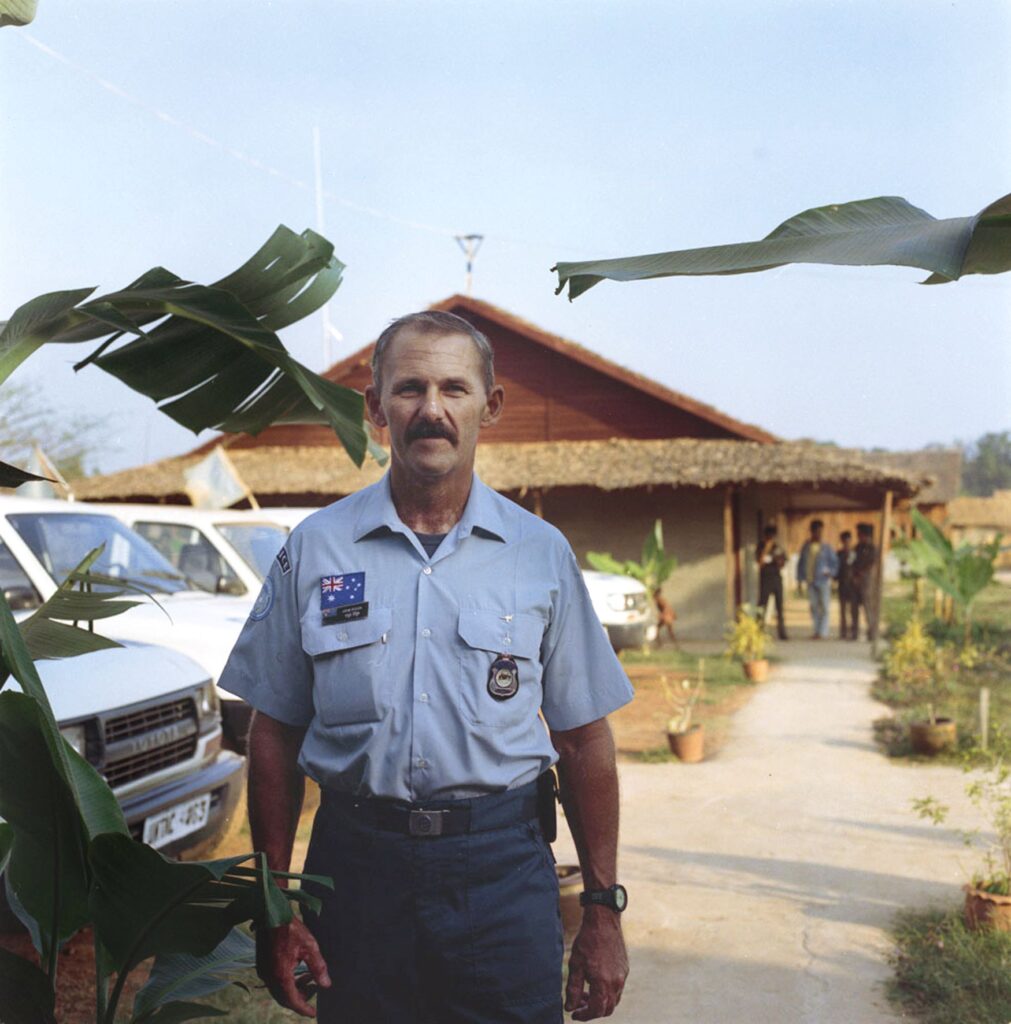
Description | ការពិពណ៌នា
Photograph: Heide Smith. Courtesy of the Australian War Memorial, P03258.223
Sergeant (Sgt) John Rixon of the Australian Federal Police (AFP), part of the first contingent of ten officers to serve with the Civilian Police (CIVPOL) Component of the United Nations Transitional Authority in Cambodia (UNTAC) from 19 May 1992 until 16 January 1993. Sgt Rixon is standing in front of a line of white UNTAC vehicles in the grounds of the Thmar Puok Police Training School which was built to train State of Cambodia (SOC) police and which was handed back to the SOC after the second contingent left in September 1993.
1993
ពលបាលត្រី John Rixon នៃសហព័ន្ធប៉ូលីសអូស្ត្រាលីដែលជាផ្នែកមួយនៃកងទ័ពជំនួយទាំង១០ ដែលធ្វើការជាមួយប៉ូលិសស៊ីវិលរបស់អ៊ុនតាក់ចាប់ពីថ្ងៃទី១៩ ខែឧសភា ឆ្នាំ១៩៩២ រហូតដល់ ថ្ងៃទី១៦ ខែមករា ឆ្នាំ១៩៩៣។ ពលបាលត្រី John Rixon កំពុងឈរនៅពីមុខខ្សែបន្ទាត់ឡានពណ៌សរបស់អ៊ុនតាក់ ដែលមានទីតាំងនៅសាលាបណ្ដុះបណ្ដាលប៉ូលិសស្រុកថ្មពួកដែលត្រូវបានកសាងឡើងដើម្បីបណ្ដុះបណ្ដាលប៉ូលិសរបស់រដ្ឋកម្ពុជា ហើយបន្ទាប់ពីកងទ័ពជំនួយចាកចេញលើកទី២ ឆ្នាំ១៩៩៣ នឹងប្រគល់ជូនរដ្ឋកម្ពុជាវិញ។
១៩៩៣
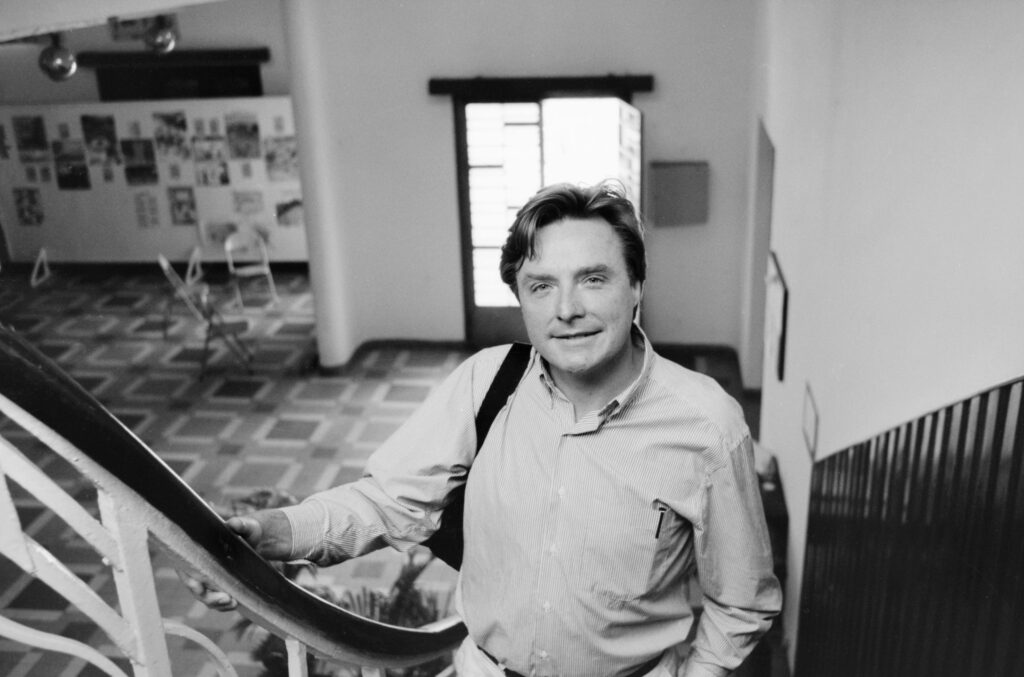
Description | ការពិពណ៌នា
Photograph: Heide Smith. Courtesy of the Australian War Memorial, P03258.243
Australian barrister at law, mediator and specialist negotiator Mark Plunkett who was appointed the United Nations’ first Special Prosecutor in 1993, attached to the Human Rights Component of the United Nations Transitional Authority in Cambodia (UNTAC). Having spent part of the previous year working for UNTAC as a Human Rights officer, Plunkett was already well aware of the type of abuses he and his staff would investigate. The component’s initial staffing allocation of ten proved woefully inadequate, while the expanded unit, consisting of one representative in each province and a small headquarters group based in Phnom Penh proved to be almost as unworkable. With a mandate to investigate war crimes, acts of genocide and human rights abuses, Plunkett encountered severe political opposition from all factions in his attempts to bring the first two human rights abuse cases before the Cambodian courts, which were rejected by Phnom Penh’s People’s Municipal Tribunal of Justice.
1993
មេធាវីអូស្ត្រាលីជាអ្នកសម្របសម្រួល និងចរចាគឺលោក Mark Plunkett ដែលត្រូវបានតែងតាំងជារដ្ឋអាជ្ញាទី១របស់អង្គការសហប្រជាជាតិក្នុងឆ្នាំ១៩៩៣ ធ្វើការលើការងារសិទ្ធិមនុស្សជាមួយអ៊ុនតាក់។ ការធ្វើការងារជាច្រើនឆ្នាំជាមួយអ៊ុនតាក់ទាក់ទងទៅនឹងសិទ្ធិមនុស្ស ធ្វើឱ្យលោក Plunkett បានយល់ដឹងជាច្រើនលើការរំលោភបំពានគ្រប់ប្រភេទដែលគាត់ និងបុគ្គលិករបស់គាត់ធ្វើការពិនិត្យស៊ើបអង្កេត។ ខណៈពេលដែលអង្គភាពបានពង្រីកសមាសភាពបុគ្គលិកដំបូងទាំង១០បានបង្ហាញពីផលលំបាកនៃការខ្វះខាតដែលម្នាក់ៗតំណាងឱ្យខេត្តមួយៗ និងទីស្នាក់កាកណ្ដាលតូចមួយនៅក្នុងទីក្រុងភ្នំពេញក៏បញ្ជាក់ដែលថាស្ទើរតែមិនអាចធ្វើការបាន។ ជាមួយកាតព្វកិច្ចត្រួតពិនិត្យបទឧក្រិដ្ឋសង្រ្គាម សកម្មភាពសម្លាប់រង្គាល និងការរំលោភបំពានសិទ្ធិមនុស្ស លោក Plunkett បានជួបប្រទះនិងបញ្ហានយោបាយប្រឆាំងដែលកើតមកពីក្រុមប្រដាប់អាវុធទាំងអស់ ដោយលោកបានព្យាយាមនាំយកករណីរំលោភបំពានពីរដំបូងមុនពេលចូលតុលាការកម្ពុជា ដែលត្រូវបានបដិសេធដោយតុលាការទីក្រុងភ្នំពេញ។
១៩៩៣
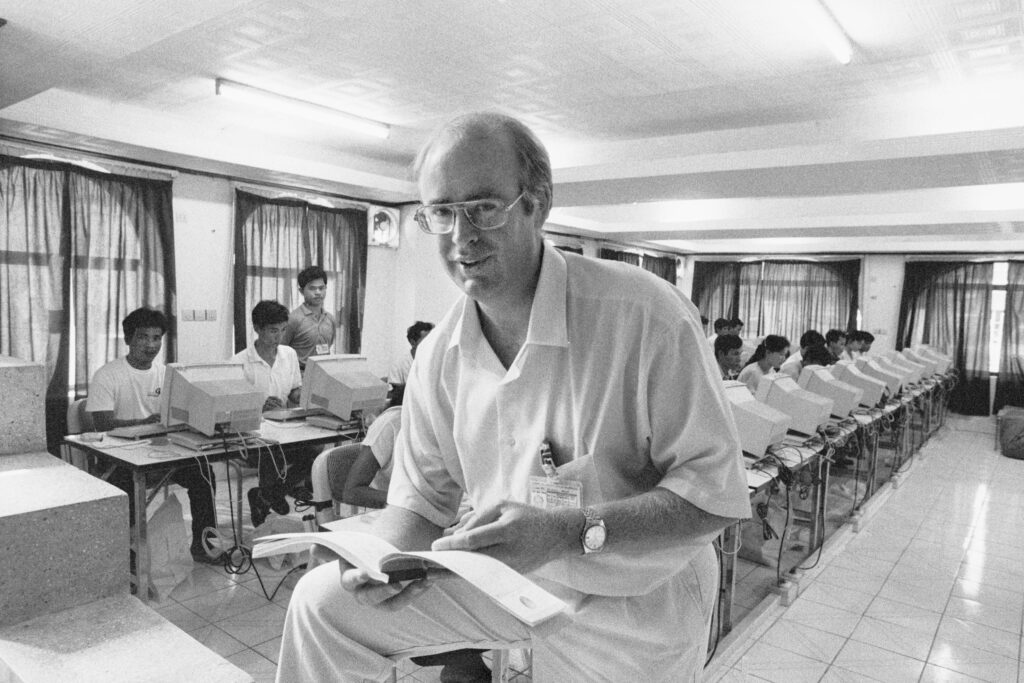
Description | ការពិពណ៌នា
Photograph: Heide Smith. Courtesy of the Australian War Memorial, P03258.287
An informal portrait of Michael Maley, an officer of the Australian Electoral Commission (AEC) who was appointed Deputy Chief Electoral Officer of the Electoral Component of the United Nations Transitional Authority in Cambodia (UNTAC). He is sitting in the Electoral Component’s Phnom Penh headquarters amongst 70 of the 280 Cambodian staff employed to process voter registration cards on a Khmer language computer database set up by the component. They are working in a modern airconditioned office environment which would have been an unusual experience in Phnom Penh in 1993, given the neglect and devastation that the capital had suffered. The role assumed by UNTAC of organising and conducting a national election was a first for the UN. Registration itself was a huge task, but of the country’s four and three quarter million eligible voters, almost one hundred percent registered – a response Maley described as ‘phenomenal’, given the amount of political intimidation experienced.
1993
រូបភាពរបស់លោក Michael Maley មន្ត្រីរៀបចំការបោះឆ្នោតអូស្ត្រាលីដែលត្រូវបានតែងតាំងជាអនុមន្ត្រីរៀបចំការបោះឆ្នោតរបស់អ៊ុនតាក់។ គាត់កំពុងអង្គុយក្នុងទីស្នាក់ការកណ្ដាលរៀបចំការបោះឆ្នោតភ្នំពេញ ជាមួយបុគ្គលិកកម្ពុជា៧០នាក់ ក្នុងចំណោមបុគ្គលិកកម្ពុជាទាំងអស់២៨០នាក់ កំពុងធ្វើកាតចុះឈ្មោះបោះឆ្នោតនៅលើកុំព្យូទ័រភាសាខ្មែរដែលរៀបចំដោយភាគីអ៊ុនតាក់។ ពួកគេធ្វើការក្នុងការិយាល័យម៉ាស៊ីនត្រជាក់ ដែលអាចជាបទពិសោធន៍ប្លែកមួយក្នុងទីក្រុងភ្នំពេញនៅឆ្នាំ១៩៩៣ ព្រោះទីក្រុងត្រូវបានរងគ្រោះយ៉ាងដំណំ ដោយត្រូវបានបោះបង់និងបំផ្លិចបំផ្លាញពីមុនមក។ តួនាទីដែលបានកំណត់ដោយអ៊ុនតាក់នៃការរៀបចំការបោះឆ្នោតជាតិដំបូងឡើយធ្វើសម្រាប់តែអង្គការសហប្រជាជាតិតែប៉ុណ្ណោះ។ ការរៀបចំការចុះឈ្មោះបោះឆ្នោតជាការងារដែលធំទៅហើយ ព្រោះតែប្រជាជនដែលមានអាយុនិងសិទ្ធិបោះឆ្នោតមានរហូតដល់៣ទៅ៤លាននាក់ ហើយស្ទើរតែ១០០%បានមកចុះឈ្មោះបោះឆ្នោត ហើយលោក Maley បានរៀបរាប់ថាជាព្រឹត្តិការណ៍ដ៏អស្ចារ្យ ព្រោះថាកម្ពុជាកំពុងនៅមានភាពតានតឹងផ្នែកនយោបាយ។
១៩៩៣
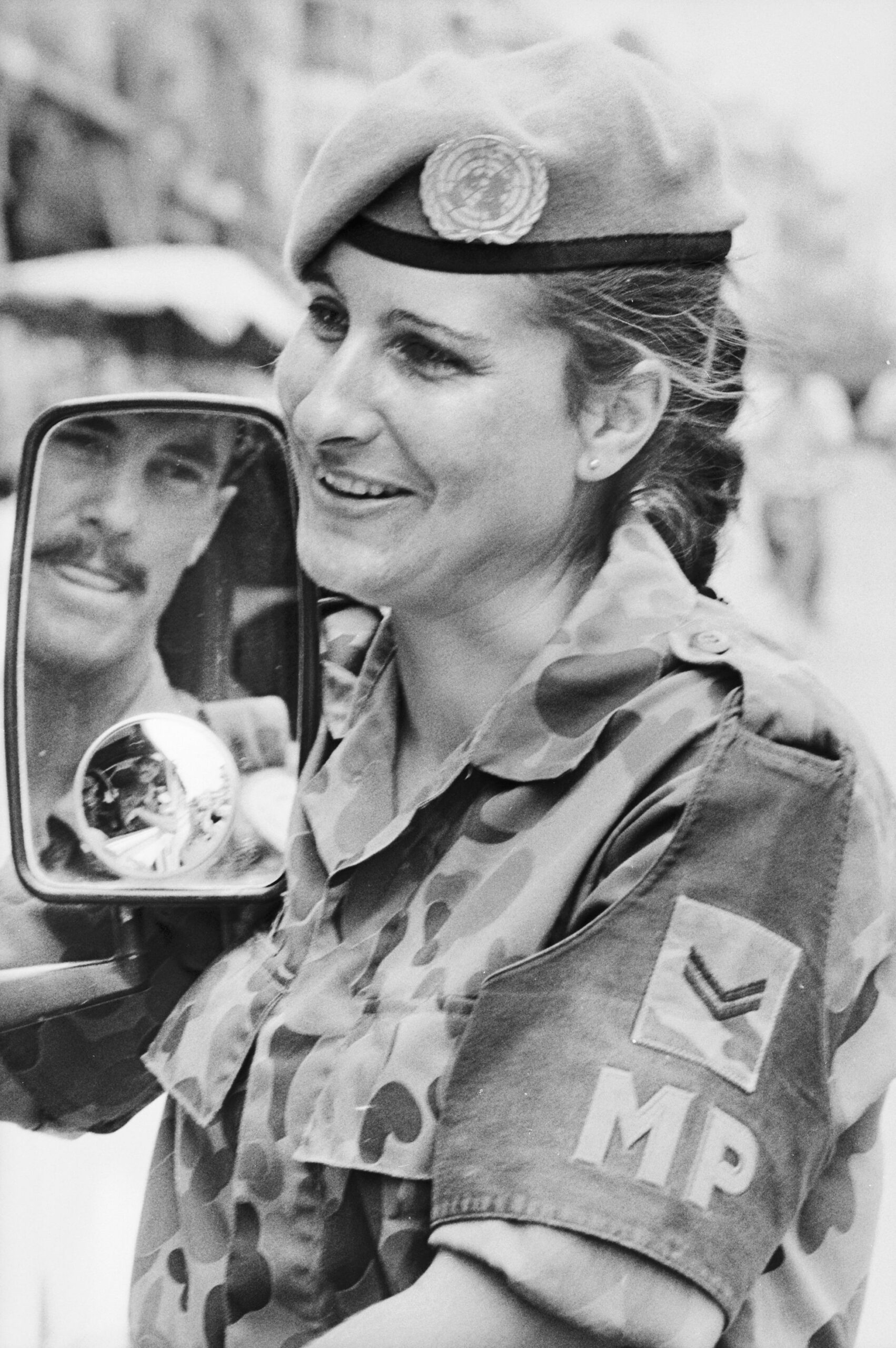
Description | ការពិពណ៌នា
Photograph: Wayne Ryan. Courtesy of the Australian War Memorial, CAMUN/92/037/26.295
On the streets, Corporal Francine Rigby of Heidelberg, Vic, talking to Warrant Officer 2 Barry James of Ipswich, Qld, both of the Royal Australian Corps of Military Police, serving with the United Nations Transitional Authority in Cambodia (UNTAC).
14 August 1992
នៅតាមដងផ្លូវ លោកពលបាលទោ Francine Rigby នៃ Heidelberg រដ្ឋ Victory កំពុងនិយាយជាមួយ មន្ត្រីធានារ៉ាប់រង គឺអ្នកស្រី Barry James នៃ Ipswich រដ្ឋ Queensland ដែលគាត់ទាំងពីរគឺជាក្រុមប៉ូលីសពិសេសរបស់ប្រទេសអូស្ត្រាលី ដែលកំពុងធ្វើការជាមួយអ៊ុនតាក់។
ថ្ងៃទី១៤ ខែសីហា ឆ្នាំ១៩៩២
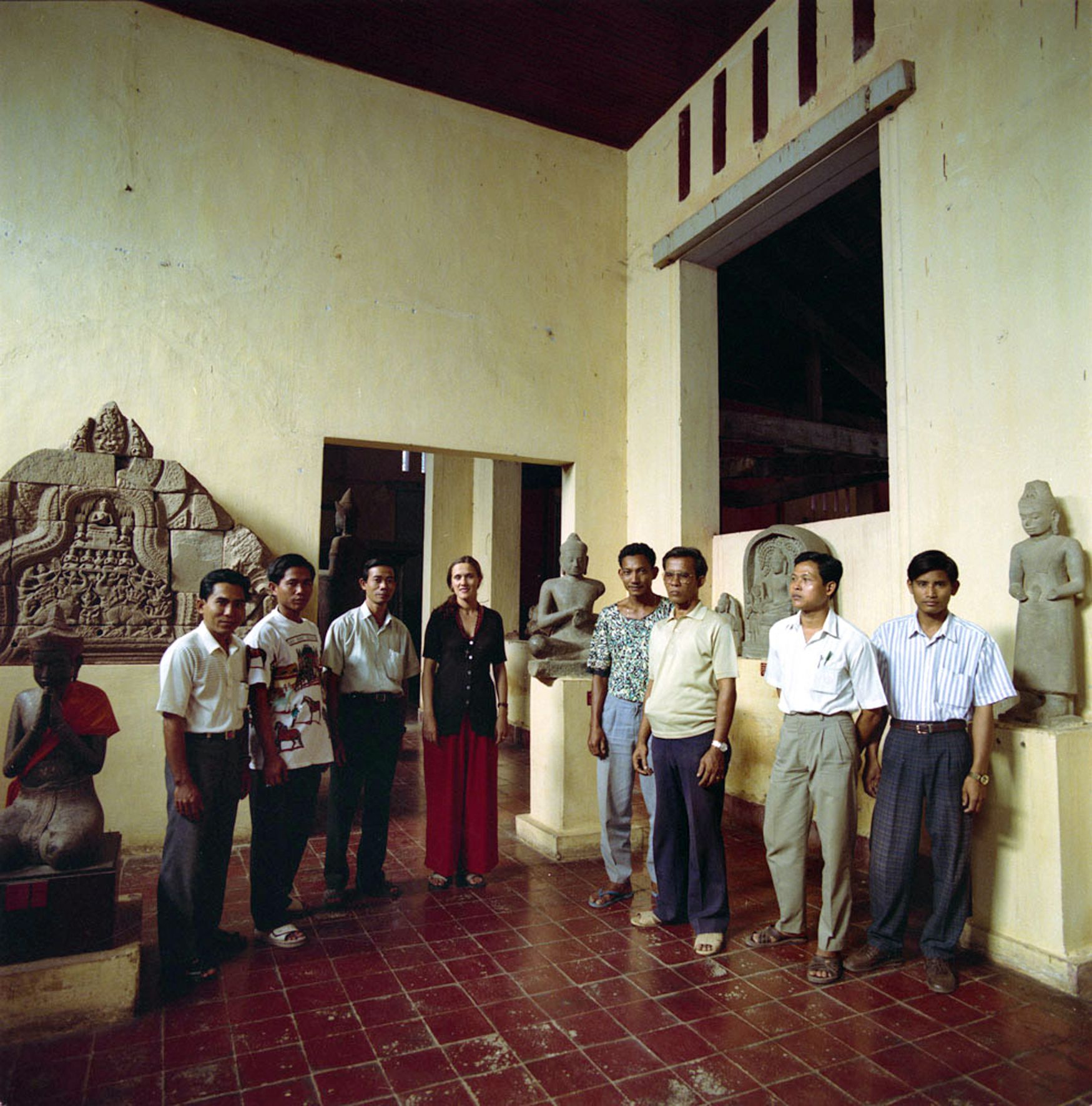
Description | ការពិពណ៌នា
Photograph: Heide Smith. Courtesy of the Australian War Memorial, P03258.314
Staff of the National Museum of Cambodia pose with Australian National Gallery (ANG, and now National Gallery of Australia) conservator Catherine Millikan (centre) in one of the Museum’s galleries among statues and carvings from the Angkor complex. Millikan was responsible for the transportation to Australia of a wide selection of artefacts from the Museum’s collections which formed the ANG’s 1992 exhibition ‘Age of Angkor’ and was chosen to manage an Australian Government funded conservation project designed to train the Museum’s staff in museum practices, maintenance and cleaning. This cultural exchange was made possible once the United Nations Transitional Authority in Cambodia (UNTAC) had established some semblance of stability. The man third from the right is Meas Khim, was head of the stone restoration workshop and the first surviving National Museum employee to return to work in 1979 after the genocidal Khmer Rouge regime, when most of the 90 French trained conservators and curators were murdered, the museum looted and records destroyed, a deliberate Khmer Rouge policy which aimed to ‘abolish, uproot and disperse the cultural, literary and artistic remnants of the imperialists, colonialists and all of the other oppressor classes”. When the Museum reopened in 1980, six of the original staff had returned, while many of the new employees were relatives of staff murdered by the Khmer Rouge. Conditions in the museum, built in Phnom Penh in 1918 by the French, reflected the years of neglect – no water or telephone, only intermittent electricity and severe structural problems caused by termites in the foundations. Adding to the alarming conditions for both staff and collection was a bat colony which resided in the Museum’s roof cavity, but which the staff turned to their advantage by monthly harvesting the bat droppings and selling them to supplement their meagre incomes.
1993
បុគ្គលិកនៃសារមន្ទីរជាតិកម្ពុជា ថតជាមួយអ្នកអភិរក្ស Catherine Millikan (នៅកណ្តាល) មកពីវិចិត្រសាលជាតិអូស្ត្រាលី (ANG) នៅក្នុងវិចិត្រសាលមួយនៃសារមន្ទីរក្នុងចំណោមរូបចម្លាក់ដែលបានឆ្លាក់ពីប្រាសាទអង្គរ។ អ្នកស្រី Millikan ទទួលខុសត្រូវចំពោះការដឹកជញ្ជូនវត្ថុបុរាណទៅកាន់ប្រទេសអូស្ត្រាលីជាច្រើនដែលបានមកពីការប្រមូលរបស់សារមន្ទីរដែលបានបង្កើតការតាំងពិពណ៌ ANG’s ១៩៩២ ពិព័រណ៍ ‘Age of Angkor’ ហើយត្រូវបានជ្រើសរើសឱ្យគ្រប់គ្រងគម្រោងអភិរក្សដែលផ្តល់មូលនិធិដោយរដ្ឋាភិបាលអូស្ត្រាលីដែលត្រូវបានបង្កើតឡើងដើម្បីបណ្តុះបណ្តាលបុគ្គលិករបស់សារមន្ទីរក្នុងការអនុវត្តធ្វើការក្នុងសារមន្ទីរ ការថែទាំ និងការសម្អាត។ ការផ្លាស់ប្តូរវប្បធម៌នេះត្រូវបានធ្វើឡើងនៅពេលដែលអាជ្ញាធរអន្តរកាលនៃអង្គការសហប្រជាជាតិប្រចាំនៅកម្ពុជា (អ៊ុនតាក់) បង្កើតឱ្យមានរូបរាងនៃស្ថិរភាព។ បុរសទីបីពីខាងស្តាំគឺលោក មាស ឃីម ដែលក្រោយមកជាប្រធានសិក្ខាសាលាជួសជុលថ្ម និងជាបុគ្គលិកសារមន្ទីរជាតិដំបូងគេដែលនៅរស់រានមានជីវិត ហើយបានវិលត្រឡប់មកធ្វើការវិញនៅឆ្នាំ ១៩៧៩ បន្ទាប់ពីរបបប្រល័យពូជសាសន៍ ស្របពេលដែលអ្នកអភិរក្ស និងអ្នកថែរក្សាជនចំនួន ៩០ នាក់ដែលជាតិបារាំងបានទទួលការបណ្តុះបណ្តាល ត្រូវបានសម្លាប់។ សារមន្ទីរត្រូវបានលួច និងបំផ្លាញ ដែលជាគោលនយោបាយរបស់ខ្មែរក្រហមដោយចេតនាដែលមានបំណង “លុបបំបាត់ កំចាត់ចោល និងបំផ្លាញសំណង់វប្បធម៌ អក្សរសាស្ត្រ និងសិល្បៈនៃចក្រពត្តិនិយម អាណានិគមនិយម និងវណ្ណៈអ្នកជិះជាន់ដទៃទៀត”។ នៅពេលដែលសារមន្ទីរបើកឡើងវិញឆ្នាំ ១៩៨០ បុគ្គលិកដើមចំនួន ៦ នាក់បានត្រឡប់មកវិញ ខណៈដែលបុគ្គលិកថ្មីជាច្រើននាក់គឺជាសាច់ញាតិរបស់ពួកគាត់ត្រូវបានសម្លាប់ដោយខ្មែរក្រហម។ ស្ថានភាពនៅក្នុងសារមន្ទីរបានសាងសង់ក្នុងទីក្រុងភ្នំពេញក្នុងឆ្នាំ ១៩១៨ ដោយជនជាតិបារាំងបានឆ្លុះបញ្ចាំងពីការទុកចោលជាច្រើនឆ្នាំ ពោលគឺគ្មានទឹក ឬទូរស័ព្ទ មានតែចរន្តអគ្គិសនីមិនទៀងទាត់ និងបញ្ហារចនាសម្ព័ន្ធធ្ងន់ធ្ងរដែលបណ្តាលមកពីសត្វកណ្ដៀរនៅក្នុងគ្រឹះ។ លក្ខខណ្ឌដែលគួរឱ្យព្រួយបារម្ភសម្រាប់ បុគ្គលិកទៀតនោះ គឺមានសត្វប្រចៀវជាច្រើនរស់នៅក្នុងប្រហោងដំបូលសារមន្ទីរ ប៉ុន្តែបុគ្គលិកបានងាកទៅរកអត្ថប្រយោជន៍របស់ពួកវាវិញ គឺដោយការប្រមូលកាកសំណល់របស់សត្វប្រចៀវរាល់ខែ និងលក់ដើម្បីបន្ថែមប្រាក់ចំណូលតិចតួចរបស់ពួកគាត់។
១៩៩៣
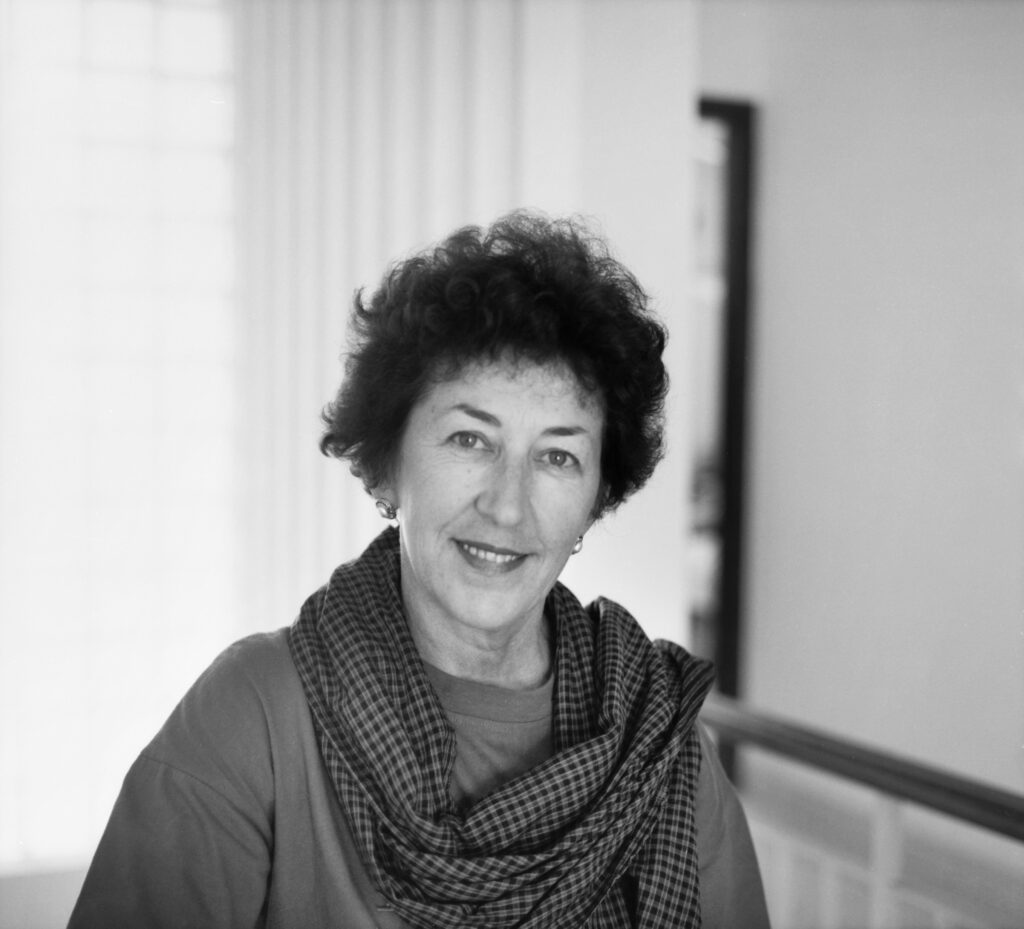
Description | ការពិពណ៌នា
Photograph: Heide Smith. Courtesy of the Australian War Memorial, P03258.401
An informal portrait of Lorraine Sanderson, wife of Lieutenant General (Lt Gen) John M Sanderson, the Force Commander of the Military Contingent of the United Nations Transitional Authority in Cambodia (UNTAC). Having joined her husband in Cambodia. Lorraine Sanderson became actively involved in aid and humanitarian work, managing the Journalists’ English Typing Centre for Australian People for Health, Education and Development Abroad (APHEDA) until APHEDA could install a Cambodian manager. Lt Gen Sanderson credits his wife’s presence as ‘critical’ when, as Force Commander, he was faced with unique and difficult decisions.
1993
រូបថតមិនផ្លូវការមួយរបស់អ្នកស្រី Lorraine Sanderson ត្រូវជាប្រពន្ធរបស់លោក ឧត្តមសេនីយ៍ឯក John M Sanderson អគ្គមេបញ្ជាការកងទ័ពជំនួយរបស់អ៊ុនតាក់ ក៏បានចូលរួមការងារជាមួយស្វាមីរបស់គាត់ក្នុងប្រទេសកម្ពុជាដែរ។ អ្នកស្រី Lorraine Sanderson បានក្លាយជាអ្នកចូលរួមយ៉ាងសកម្មនៅក្នុងកិច្ចការជំនួយ និងការងារមនុស្សធម៌ ការគ្រប់គ្រងមជ្ឈមណ្ឌលសរសេរអត្ថបទសារព័ត៌មានភាសាអង់គ្លេស សម្រាប់កម្មវិធី ប្រជាជនអូស្ត្រាលីដើម្បី សុភាព ការអប់រំ និងការអភិវឌ្ឍក្រៅប្រទេស (APHEDA) រហូតដល់ APHEDA អាចតែងតាំងអ្នកគ្រប់គ្រងជាជនជាតិខ្មែរបាន។ ឧត្តមសេនីយ Sanderson ចាត់ទុកវត្តមានរបស់ភរិយារបស់គាត់ជាការ “សំខាន់” នៅពេលដែលគាត់ជាមេបញ្ជាការកងកម្លាំង គាត់ត្រូវប្រឈមមុខនឹងការសម្រេចចិត្តដ៏ប្លែក និងពិបាក។
១៩៩៣
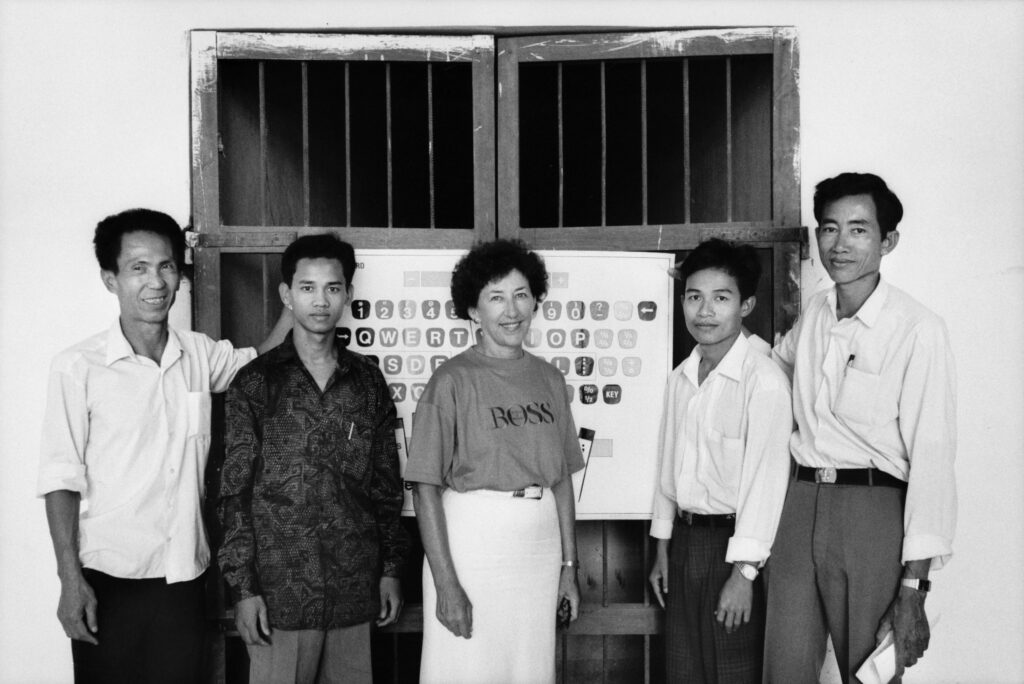
Description | ការពិពណ៌នា
Photograph: Heide Smith. Courtesy of the Australian War Memorial, P03258.404
Posing in front of a keyboard chart outside the Journalists’ English Typing Centre located in Phnom Penh, are Lorraine Sanderson (centre) and a group of students. The Centre was established in May 1992 by Australian journalist Sue Downie and Barbara Fitzgerald, the director of Australian People for Health, Education and Development Abroad (APHEDA), the Australian trade union movement’s aid agency which focuses on enhancing technical and vocational skills in developing countries. Designed to assist Cambodian journalists, government workers and the disabled with free training in English typing and journalistic skills, the Centre received a major boost in 1991 and 1992 from appeals launched in Canberra, Australia for typewriters and associated equipment, resulting in almost 500 pieces of equipment being donated, many of which were then distributed throughout the rest of Cambodia. Until APHEDA was able to train two additional teachers and a coordinator, Lorraine Sanderson, wife of Lieutenant General (Lt Gen) John M Sanderson, the Force Commander of the Military Contingent of the United Nations Transitional Authority in Cambodia (UNTAC), managed the Centre.
1993
អ្នកស្រី Lorraine Sanderson (នៅកណ្ដាល) និងសិស្សមួយក្រុមកំពុងឈរនៅពីមុខក្ដារខៀនបង្ហាញពីក្ដារចុចនៅខាងក្រៅមជ្ឈមណ្ឌលសរសេរអត្ថបទសារព័ត៌មានជាភាសាអង់គ្លេស។ មជ្ឈមណ្ឌលនេះត្រូវបានបង្កើតក្នុង ខែឧសភា ឆ្នាំ១៩៩៣ ដោយអ្នកសារព័ត៌មានអូស្ត្រាលីគឺ Sue Downie និង Barbara Fitzgerald ដែលជានាយកនៃ កម្មវិធី ប្រជាជនអូស្ត្រាលីដើម្បី សុភាព ការអប់រំ និងការអភិវឌ្ឍក្រៅប្រទេស (APHEDA) និង ភ្នាក់ងារចលនាជំនួយសហជីពអូស្ត្រាលីដែលផ្ដោតសំខាន់លើការដោះស្រាយបញ្ហាជំនាញបច្ចេកទេស និងវិជ្ជាជីវៈនៅក្នុងប្រទេសកំពុងអភិវឌ្ឍន៍ ដែលបានរៀបចំឡើងដើម្បីជួយអ្នកសារព័ត៌មានកម្ពុជា មន្ត្រីរាជរដ្ឋាភិបាល និងជនពិការក៏ទទួលបាននៅការបណ្តុះបណ្តាលដោយឥតគិតថ្លៃលើជំនាញវាយអក្សរភាសាអង់គ្លេស និងជំនាញសារព័ត៌មាន។ មជ្ឈមណ្ឌលបានទទួលការជ្រោមជ្រែងយ៉ាងធំមួយក្នុងឆ្នាំ ១៩៩១ និង ១៩៩២ ពីការអំពាវនាវដែលបានចាប់ផ្តើមនៅទីក្រុងកង់បេរ៉ា ប្រទេសអូស្ត្រាលី សម្រាប់ម៉ាស៊ីនអង្គុលីលេខ និងឧបករណ៍ពាក់ព័ន្ធ ជាលទ្ធផលគឺមានឧបករណ៍ជិត ៥០០ ត្រូវបានបរិច្ចាគហើយភាគច្រើនត្រូវបានចែកចាយទូទាំងប្រទេសកម្ពុជា។ រហូតទាល់តែ APHEDA អាចបណ្តុះបណ្តាលគ្រូបន្ថែមពីរនាក់ និងអ្នកសម្របសម្រួលមួយរូប គឺអ្នកស្រី Lorraine Sanderson ភរិយារបស់ឧត្តមសេនីយឯក John M Sanderson អគ្គមេបញ្ជាការនៃកងទ័មជំនួយនៃអាជ្ញាធរអន្តរកាលអង្គការសហប្រជាជាតិនៅកម្ពុជា (អ៊ុនតាក់) ដែលជាអ្នកគ្រប់គ្រងមជ្ឈមណ្ឌល។
១៩៩៣
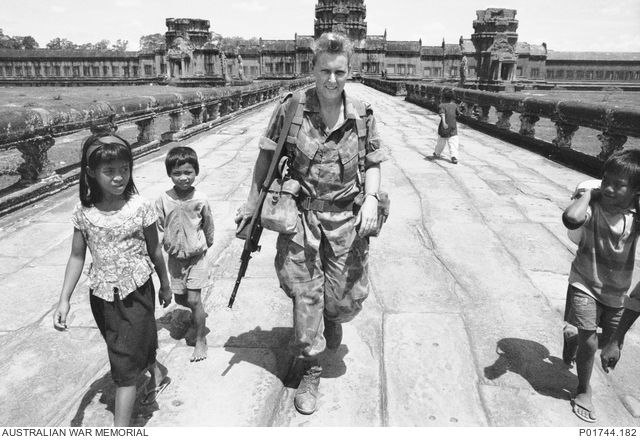
Description | ការពិពណ៌នា
Photograph: Heide Smith. Courtesy of the Australian War Memorial, P03258.404
Leading Aircraftwoman (LACW) Michelle (Mitch) Stevens RAAF, a woman serving with the United Nations Transitional Authority in Cambodia (UNTAC), on patrol at the temple complex of Angkor Wat, accompanied by some inquisitive Cambodian children. LACW Stevens is dressed in Disruptive Pattern Combat Uniform (DCPU) and is carrying a 5.56mm caliber Styr AUG rifle. (Original negative housed in AWM Archive Store)
ពលទាហានកងទ័ពអាកាស (LACW) គឺអ្នកស្រី Michelle (Mitch) Stevens RAAF ជាស្ត្រីម្នាក់ដែលកំពុងបម្រើការជាមួយអាជ្ញាធរអន្តរកាលអង្គការសហប្រជាជាតិនៅកម្ពុជា (អ៊ុនតាក់) កំពុងល្បាតនៅបរិវេណប្រាសាទអង្គរវត្ត ដែលត្រូវបានអមដំណើរដោយកុមារកម្ពុជាមួយចំនួន ។ LACW Stevens បានស្លៀកឈុតកងការពារ Disruptive Pattern Combat Uniform (DCPU) ហើយកំពុងកាន់កាំភ្លើង Steyr AUG ទំហំ 5.56mm។
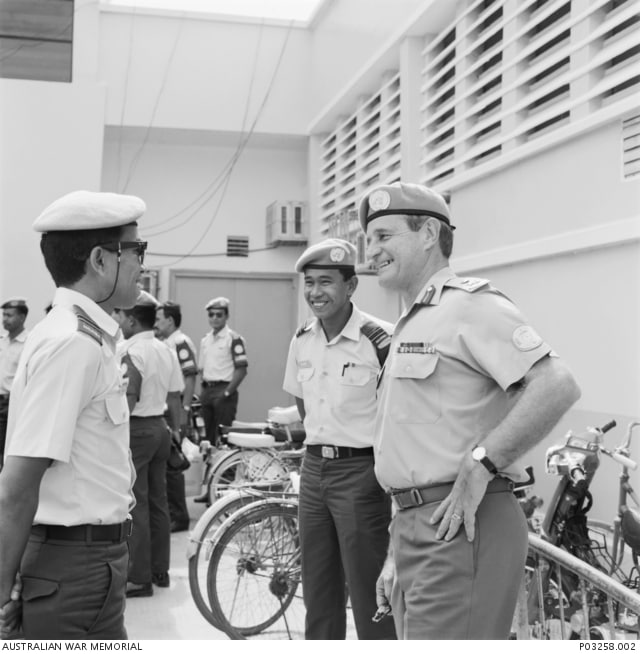
Description | ការពិពណ៌នា
Lieutenant General (Lt Gen) John M Sanderson, Force Commander of the Military Contingent of the United Nations Transitional Authority in Cambodia (UNTAC) greets members of the Royal Malaysian Air Force (RMAF), part of the Malaysian Contingent to Cambodia, at Phnom Penh Airport. Known as the RMAF Technical Specialist Group (TESPEG), the group consisted of Air Traffic Controllers, Fire Fighters and Base Operation personnel tasked with contributing to UNTAC’s aerial operations requirements. Malaysia committed a total of 1,090 military personnel to the UNTAC operation, including eight Sikorsky S-61 helicopters and a Ranger Battalion, one of 34 countries to commit troops.
ឧត្តមសេនីយ៍ឯក John M Sanderson អគ្គមេបញ្ជាការកងកម្លាំងប្រដាប់អាវុធនៃអាជ្ញាធរអន្តរកាលអង្គការសហប្រជាជាតិនៅកម្ពុជា (អ៊ុនតាក់) បានជួបស្វាគមន៍សមាជិកនៃកងយុទ្ធពលដែនអាកាសរបស់ប្រទេសម៉ាឡេស៊ី(RMAF) នៅអាកាសយានដ្ឋានភ្នំពេញ ដែលជាផ្នែកមួយនៃកងទ័ពជំនួយរបស់ប្រទេសម៉ាឡេស៊ីប្រចាំនៅប្រទេសកម្ពុជា ហើយត្រូវបានគេស្គាល់ថាជាក្រុមឯកទេសបច្ចេកទេសពិសេសមួយ RMAF (TESPEG) ដែលក្រុមនេះមាន អ្នកត្រួតពិនិត្យចរាចរណ៍ផ្លូវអាកាស អ្នកពន្លត់អគ្គីភ័យ និងកងទ័ពប្រតិបត្តិការមូលដ្ឋានដែលមានភារកិច្ចក្នុងការរួមចំណែកការធ្វើប្រតិបត្តិការផ្លូវអាកាសរបស់អ៊ុនតាក់។ ប្រទេសម៉ាឡេស៊ីបានបញ្ជូនកងយោធាសរុបចំនួន ១០៩០ នាក់នៅក្នុងប្រតិបត្តិការរបស់អ៊ុនតាក់ រួមទាំងឧទ្ធម្ភាគចក្រ Sikorsky S-61 ចំនួនប្រាំបីគ្រឿង និងកងវរសេនាតូច Rangerមួយកង ដែលជាប្រទេសមួយក្នុងចំណោមប្រទេសចំនួន ៣៤ ដែលផ្ដល់ជំនួយ។
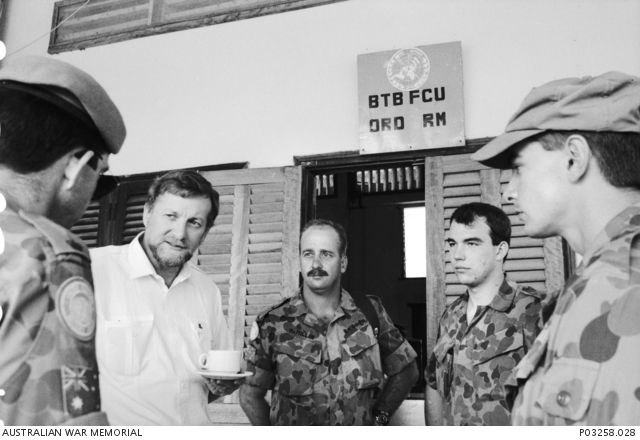
Description | ការពិពណ៌នា
Senator Gareth Evans (second left) speaks to Australian and New Zealand members of the Australian Force Communications Unit (FCU) in front of the orderly room at their base at Battambang during his visit to Cambodia on 22 – 23 January 1993, having flown up to the base from Phnom Penh by helicopter. After his formal speech, Evans took the opportunity to chat informally with personnel about conditions that the contingent was facing in the surrounding region, which was close to a number of Khmer Rouge controlled areas. Evans remembers the FCU team as being “tremendously impressive: alert, capable, resourceful, and with really good relationships with the local people.” He also visited another Australian FCU base at Kompong Thom in central Cambodia and the Australian Federal Police (AFP) contingent at their base at Thmar Puok near the Thai border, where, as Evans relates “they had been trying among other things to build bridges with some Khmer Rouge soldiers”. Evans’ visit was designed to gauge UNTAC’s progress towards the cantonment and demobilisation of all Cambodian military forces before the May 1993 elections.
សមាជិកព្រឹទ្ធសភា Gareth Evans (នៅខាងឆ្វេងទីពីរ) និយាយជាមួយសមាជិកអូស្ត្រាលី និងនូវែលហ្សេឡង់ នៃអង្គភាពទំនាក់ទំនងកងកម្លាំងអូស្ត្រាលី (FCU) នៅមុខបន្ទប់ចាស់មួយនៅមូលដ្ឋានរបស់ពួកគេក្នុងខេត្តបាត់ដំបង ក្នុងដំណើរបំពេញទស្សនកិច្ចនៅប្រទេសកម្ពុជា នាថ្ងៃទី ២២-២៣ ខែមករា ឆ្នាំ ១៩៩៣ ដោយបានហោះហើរពីមូលដ្ឋានទីក្រុងភ្នំពេញតាមឧទ្ធម្ភាគចក្រ។ បន្ទាប់ពីថ្លែងសុន្ទរកថាផ្លូវការរបស់គាត់ហើយ លោក Evans បានឆ្លៀតឱកាសជជែកក្រៅផ្លូវការជាមួយពលទាហានអំពីលក្ខខណ្ឌដែលក្រុមទាហានកំពុងប្រឈមមុខនៅក្នុងតំបន់ជុំវិញ ដែលនៅជិតតំបន់គ្រប់គ្រងដោយខ្មែរក្រហមមួយចំនួន។ លោក Evans ចាំថា “ក្រុម FCU គឺជាក្រុមដែលគួរឱ្យចាប់អារម្មណ៍យ៉ាងខ្លាំង ដោយមាន ការប្រុងប្រយ័ត្នខ្ពស់ មានសមត្ថភាព ជានធនធានដ៏ល្អ និងមានទំនាក់ទំនងល្អជាមួយប្រជាជនក្នុងតំបន់”។ លោកក៏បានទៅទស្សនាមូលដ្ឋានទ័ព FCU របស់អូស្ត្រាលីមួយទៀតនៅខេត្តកំពង់ធំ ដែលជាខេត្តនៅចំកណ្តាលនៃប្រទេសកម្ពុជា និងក្រុមប៉ូលីសសហព័ន្ធអូស្ត្រាលី (AFP) នៅ មូលដ្ឋានរបស់ពួកគេក្នុងស្រុកថ្មពួក ជិតព្រំដែនថៃដែលលោក Evans មានប្រសាសន៍ថា “ពួកគេបាននិងកំពុងព្យាយាមក្នុងការសាងសង់ស្ពានជាមួយនិង ទាហានខ្មែរក្រហមខ្លះៗហើយ”។ ដំណើរទស្សនកិច្ចរបស់លោក Evans ត្រូវបានរៀបចំឡើងដើម្បីវាយតម្លៃការវឌ្ឍនរបស់អ៊ុនតាក់ ឆ្ពោះទៅរកការបោះជុំទ័ព និងការរំសាយទ័ពទាំងអស់នៅកម្ពុជា មុនការបោះឆ្នោតខែឧសភា ឆ្នាំ១៩៩៣។